Issue Four 2023 Leadership



National Print & Sign Owners Association (NPSOA) is an organization dedicated to serving the needs of sign and print owners across the country.


1. ACCESS TO INDUSTRY RESOURCES: Take advantage of a wide range of industry resources including: educational materials, best practices, & ample networking opportunities. Stay up-to-date with the latest trends and techniques within the industry and grow business.
2. COST SAVINGS: Exclusive discounts on products and services from a variety of industry partners including: suppliers, manufacturers, and service providers. These cost savings can help improve profitability and stay competitive in a challenging market.
3. COMMUNITY AND SUPPORT: Connect with other professionals in the industry, share ideas and experiences, and build relationships that can help nurture business success.
If you are an owner, you need to join!
npsoa.org/members/join-renew-npsoa/
Make the move to digital – and unbox your business with the power of just-in-time jobs, fast-cycle proofs and prototypes, and customized campaigns.
With the new EFITM Nozomi 14000 LED digital press for corrugated packaging and POS, you can offer endless creative opportunities with VDP, white ink, and more. And personalise runs from one to infinity at higher margins and with lower costs – all in a single pass.


Let’s build your brilliant future. Together. Scan to learn how corrugated converters and packaging printers are opening up new opportunities.
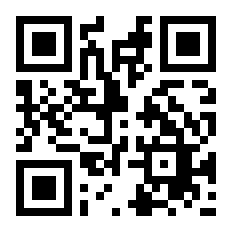

Wayne Lynn
Ken Garner
Joanne Gore
Steve Johnson
Ralf Schlözer
Heidi Tolliver-Walker
Welcome to the Leadership Issue.
Nothing says excellent print business leadership better than taking top honors in the WhatTheyThink “Top 100 Small Commercial Printers,” and this year that honor goes to Nashville’s Allen Printing Company—for many years a bridesmaid, now finally a bride. In 2022, the shops included in our Top 100 list accounted for more than half a billion dollars in revenue—$520,648,875, representing a 5.8% increase from 2021. See page 16 for our complete coverage of this year’s Top 100, including business conditions, challenges, investments and new application areas. We also have a chat with Allen Printing’s Paul Heffington.
Also in this issue, Cary Sherburne conducts our annual Print Franchise Review (see page 24). In a departure from previous years, this year’s Franchise Review focuses less on financials and quantitative metrics and more on the leadership aspects of running a franchise network. How are they growing centers? How are they pursuing new applications? How are they grooming the next generation of franchise leadership? In another departure from previous years, we have uncoupled the Sign Franchise Review and will look at the sign franchises in a future issue.
Joanne Gore examines the qualities that make a good leader—be it of a print business or in general—with an emphasis on promoting well-being. Wayne Lynn takes a deep dive into developing leadership, and Ken Garner talks about mentorship.
Special thanks to our Leadership Issue sponsor, Canon Solutions America. Our Executive Q&A this issue is with Canon’s Francis McMahon, who talks at length about his leadership style, which he describes as “corporate hippie.” Check it out on page 32, and see if you don’t start humming “Magic Bus.”














 Francis A. McMahon — Executive Vice President, Production Print Solutions, Canon
Francis A. McMahon — Executive Vice President, Production Print Solutions, Canon
 America
America
It’s no secret production inkjet technology is widely considered the future of the printing industry, or that Canon Solutions America is at the forefront its evolution. According to InfoTrends, we currently hold 41% of US total high-volume inkjet market share.1 And once again Canon was named a Leader in the IDC MarketScape: Worldwide High-Speed Inkjet Press 2023 Vendor Assessment.2 We got here by prioritizing customer success.
By listening to our customers, we’ve been able to develop solutions that help them experience enhanced productivity and increased automation. And now, as customers continue to face challenges related to labor, costs, and selling the value of print in a digital world, we are doing everything in our power to help them tackle each one.
Canon inkjet presses are easy to use without requiring complex skill sets, and one operator can operate multiple presses. With installation, we also provide on-site training and easy onboarding for press operators. Additionally, Canon offers automated end-to-end solutions that maximize productivity and minimize intervention and manual processes.
Our Professional Services team can help you better automate your workflow and printing processes, helping to drive costs out of your operation. Our expert analysts become trusted strategic advisors who help maximize return on your Canon inkjet investment by customizing the right solutions for optimizing production workflows, attracting new opportunities, and preparing your business for profi table growth.
Canon is proud to sponsor the thINK user group of Canon inkjet customers. Through membership, customers have access to valuable resources that help accelerate sales, including pre-designed print samples and lead gen tools that help promote the value of print and inkjet’s capabilities.

Our inkjet technology promises high quality 1200 dpi output and the ability to maintain that quality over long runs with easy-to-operate presses. This helps enable print providers to expand into more markets — including premium direct mail, general commercial print, and photo specialty — in addition to continuing to serve our core in the transactional and book printing markets.
Canon’s production inkjet portfolio showcases three different 1200 dpi presses spanning various monthly duty cycles and accommodating a wide variety of qualified paper options. Whatever market, whatever application, whatever volume, Canon has a production inkjet press to help each and every customer be successful.
listening to our customers, we’ve been able to develop solutions that help them experience enhanced productivity and increased automation.


There is a growing body of research suggesting that companies with a higher percentage of women on their leadership teams tend to perform better financially than those with fewer women in leadership positions. This phenomenon is not simply a matter of fairness or equity. It appears to be directly linked to improved business outcomes.
Studies have consistently found that companies with more diverse leadership teams are more likely to outperform their peers. For example, a study by McKinsey & Company found that companies in the top quartile for gender diversity on their executive teams were 25% more likely to have above-average profitability than companies in the bottom quartile.
A plethora of studies backup these results. For instance, Catalyst conducted a study that


revealed that companies with greater representation of women on their board of directors enjoyed higher return on equity, sales and invested capital compared to those with fewer women on their boards.
Another survey conducted by the Peterson Institute for International Economics, which covered 21,980 publicly traded companies across 91 countries, discovered that an increased number of female leaders in top positions of corporate management was positively associated with enhanced profitability.
Why does having more women in leadership positions improve a company’s financial performance?
Women bring different perspectives and experiences to the table. This can lead to more creative and innovative solutions, as diverse teams are
more likely to generate new ideas and approaches. In addition, women tend to be more collaborative and inclusive, which can lead to better decision-making and more effective teamwork.
Women tend to be more highly educated. Higher levels of education tend to lead to more diverse perspectives.
According to the Harvard School of Public Health, women in the United States hold 57% of bachelor’s degrees, 62%+ of master’s degrees and 53% of advanced professional degrees such as PhDs, medical degrees and law degrees.
Having more women in leadership positions helps companies better understand and serve their customer bases. Women make up a significant portion of the consumer market, and companies with more women in leadership positions are better equipped
to develop products and services that meet the needs and preferences of female consumers.
Companies with more women in leadership positions tend to have better employee engagement and retention. Not only are women more likely to be satisfied with their jobs and committed to their employers when they see opportunities for them to advance, but job engagement and performance for an employer’s team overall tend to be higher under women’s leadership, as well.
Companies with women directors deal more effectively with risk and focus more on long-term priorities. They are more likely to encourage thorough discussions and deliberations, and by bringing more diverse perspectives and experiences to the table, they can help identify risks and opportunities that may have been overlooked.
Even with so much evidence of the value of women in leadership, too many companies are still upside-down in this area—and to their own detriment. Now it’s up to individual companies to take the necessary steps to turn this around.
How can companies increase the percentage of women on their leadership teams? The first step is to prioritize diversity and inclusion as a business imperative. This means…
• Setting targets for gender diversity at all levels of the organization and holding leaders accountable for meeting these targets
• Creating a culture that values and celebrates diversity and providing training and development opportunities to help women advance into leadership roles
• Taking steps to remove barriers that may be preventing women from advancing
• Taking steps to keep them from leaving once they do reach positions of leadership
Why are qualified women leaving their roles?
According to a 2022 study from McKinsey & Company…
• Lack of opportunity to advance (48%)
• Lack of manager support (22%)
• Lack of flexibility (20%)
• Organization’s lack of commitment to diversity, equity, inclusion (DEI) (18%)
• Organization’s lack of commitment to well-being (17%)
All of these are factors fully within the organization’s control.
After decades of research, the data points to the same conclusion. A healthy, thriving company culture, and a company’s healthy bottom line, benefit from the diversity of perspectives and approaches that come with diversity in leadership. Increasing the percentage of women on a company’s leadership team is not only the right thing to do from a social justice perspective. It is just good for business.
Drawing on six years’ worth of Print Business Outlook surveys, our “Tales from the Database” series looks at historical data to see if we can spot any particular hardware, software or business trends. This issue, we turn our attention to leadership.
These surveys form the basis of our annual “Printing Outlook” reports, We ask a broad cross-section of print businesses about business
If we take a look back into our database of Print Business Outlook Survey results, we note that in 2018, there was a spike in owner retirement—26% of survey respondents selected “owner/management retirement” as a business challenge—which then settled down the following year.

In 2018, the industry had been on a resurgence over the course of the 2010s, and at the time we remarked that 2019 was like a return to the 1990s. So it’s possible that a larger-than-usual cohort of print business owners and upper managers took the opportunity to retire.
This challenge declined for a survey, then in 2020 started an upward trend. We know anecdotal-
conditions, challenges, new opportunities and planned investments.
In our “Business Outlook” reports, we tend to focus (obviously) on the most recent survey data, occasionally looking back a survey or two to see how these items have changed in the short-term. Plumbing the depths of our survey database can give us a better sense of how these trends have changed since the mid-2010s.
ly that, at least in the franchise networks, a fair number of franchise owners took the opportunity of the pandemic to retire, and now that the pandemic is generally over and the printing industry is back in the black, we could be looking at the next wave of print business owner retirements.
Another way of looking at this is via hiring plans. Here we show the percentage of print businesses that plan to hire staff in the next year, including executive management.
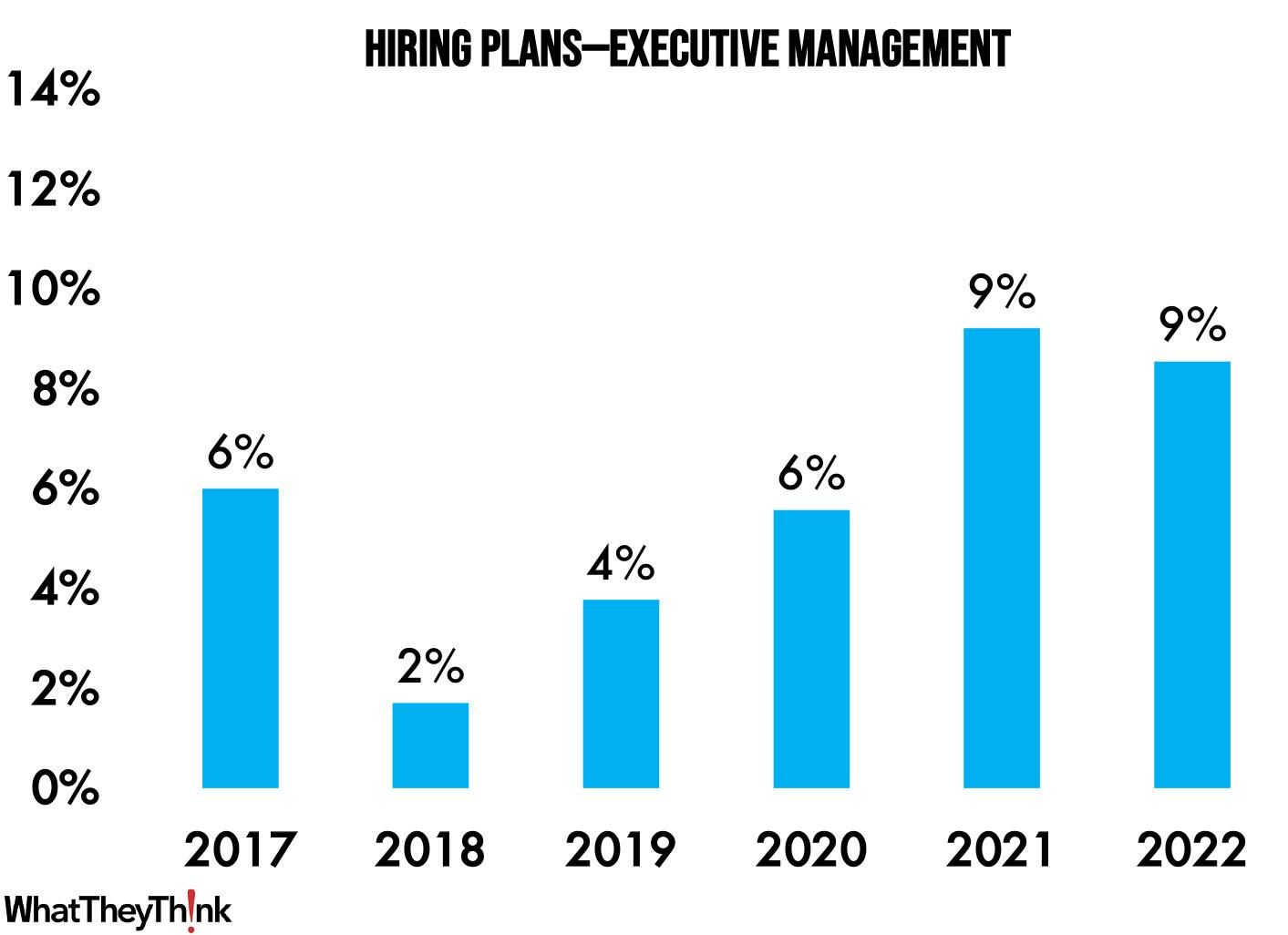
Not that this number has ever been especially high, but it has started to climb after 2018. Ideally, future leadership positions would be promoted from within, as they are the most likely to already understand the prevailing company culture. But that isn’t always possible.
Sometimes a business will respond to potential owner retirement by selling itself. Has that been the case for print businesses? Not really. “Selling our business” has never been higher than 10% as a sales opportunity. In the 2018–2019 period it actually dropped.

“Acquiring another company” has had more appeal to print businesses, as a way of not only acquiring a book of business but also new capabilities.
A lot of commercial printers acquired wide-format printing capabilities this way. It did spike in 2020 as there was a surfeit of print businesses that couldn’t make it on their own through the pandemic.
Acquiring a company can also be a good way to
amass a new pool of potential leaders. The ability to find new employees at all has become more challenging—and that will make it more difficult to groom the printing business and industry leaders of the future.
There is another long-term demographic trend that will also impact the ability to find employees and management. We wrote about this last month in our Friday data slice’n’dice feature. The National Center for Health Statistics released “Births: Provisional Data for 2022,” and reported that “the provisional number of births for the United States in 2022 was 3,661,220, a nonsignificant decline from 2021.”
Look at the period after the Great Recession of 2008. The U.S. birth rate started to drop and has continued through 2020.

Marco Boer of IT Strategies has been sounding the alarm on this trend for the past several years, and David Zwang brought it up in his Technology Outlook webinar.
Ultimately, what this means is that starting in 2026, substantially fewer people will be entering
the workforce and, by extension, the printing industry. Ultimately, we’re looking at 500,000 fewer U.S. workers between 2026 and 2036. Add to that the aging of the current workforce, and if you were expecting the labor shortage problem to sort itself out…well, it’s only going to get worse.
On the plus side, the way automation—both hardware and software—is evolving, it may be the cure for the missing worker blues. So if you aren’t hiring robots now, you soon may be. And they may be running the company before long.
Which raises an interesting question. If that post2020 line continues to go up and the birth rate returns to pre-recession levels by, say, 2036, with all the automation that is going to exist by then, will there be any jobs for the increased number of people entering the workforce after 2056?
Each year, WhatTheyThink invites small commercial print business owners to participate in our “Top 100 Shops Survey.” The key word is “small,” with the upper limit for participation at $25 million in annual revenues.
Last year’s winner was Strategic Factory (their second straight win), and in this space last year we had said, “Given their trajectory, it’s possible they won’t qualify next year”—as indeed was the case.
Their 2022 revenues exceeded $26 million, thus disqualifying them from this year’s contest. We can’t think of a better reason for being disqualified! So kudos to Strategic Factory—our loss is their gain.
Which means that we have a new “Top Shop” this year. This year’s winner is no stranger to our “Top Five,” and it’s great to see that this year they made it to the top: Allen Printing Company, with 2022 sales of $24.3 million. Congratulations to Allen Printing Company!
In 2022, the shops included in our “Top 100” list accounted for more than half a billion dollars in revenue—$520,648,875, representing a 5.8% increase from 2021. If we look at revenues for our top shops, 74% saw a 10%+ increase in revenues in 2022 from 2021, while 12% said 2022 saw a 6–10% increase over 2021. A further 7% saw a
1–5% increase in revenues in 2022. Only 5% reported any decrease in revenues in 2022. (We won’t adjust for inflation.)
As for their expectations for 2023, they are a little muted: 8% are expecting revenues to decrease, 45% are expecting revenues to increase more than 10%, and 24% are expecting revenues to increase between 6% and 10%.
Part of this lack of optimism is what we know from our “Fall 2022 Business Outlook Survey”: 2022 still represented the recovery of work lost to the pandemic, and 2023 will be a settling back into normality. At the same time, we also know anecdotally that many businesses are expecting a recession in 2023—even if there is no sign of one.


If you look at our list of “Top Shops,” you’ll notice a large number are franchises—lots of Allegras, AlphaGraphics, Sir Speedys and PIPs. If you read Cary’s Sherburne’s “Franchise Review,” you know that franchise networks have been growing, and individual franchisees have been expanding into new product areas, like signage and display graphics. It also has to be said that individual franchisees were encouraged by their respective Mother Ships to respond to our survey, whilst indie print businesses were a lot more difficult to wrangle.
While we’d like to get a lot more independent printer participation, we unfortunately don’t have subpoena power. And, alas, some of the Top 10 shops from previous years also did not participate this year. We can only hope it was because they “succeeded” their way past our sales cutoff.
The oldest company in our “Top 100” this year is State College, Pa.’s K-B Offset Printing, founded in 1902, while the newest company is AlphaGraphics Suwanee (Ga.), founded in 2019. The median founding date for all companies in the “Top 100” was 1988.
The majority of our respondents have one location, but at the high end, N.E.W. Printing in Appleton, Wis., reported 38 locations. In the “Top 10,” two locations are the average.
In terms of employees, the average number of full-time and part-time employees in the “Top 100” is 25.8; our top two shops this year, Speedy CPS and Allen Printing Company, top the list at 147 and 130 employees, respectively.

Print businesses are becoming nothing if not more diverse in the kinds of applications they produce. When we look at the specific kinds of applications shops produce, we find a wide range of print products, including color digital printing/copying (produced by 97% of our “Top Shops”), wide format (89%), mailing (89%), black-and-white digital printing/copying (87%), and binding and finishing (86%).
This year’s top challenges—and none will surprise you in the slightest—are “national economic conditions,” selected by 52% of our “Top Shops.” Here we find recession paranoia—again. “Managing workflow automation” is number two at 50%, and “finding qualified production personnel” is number three at 42%.
We note that “availability of consumables and supplies”—which was the top challenge in our
“Fall 2022” survey—is only at 18% here, so the “supply chain issues” that plagued print businesses last year have largely resolved themselves.
Despite the top challenge being “national economic conditions,” we find “improving economic conditions” to be far down the list of business opportunities. Rather, the top opportunity is “customers outsourcing more work to us” at 44%.
Our boilerplate explanation for this opportunity is that there is always the danger that customers will be able to satisfy a substantial amount of their own printing needs in-house, whether that be “quick print” work or even some wide-format or other specialty printing. This is especially the case in the current environment, where businesses throughout the economy need to cut costs as much as possible. A new wrinkle to this opportunity is that companies throughout the economy simply don’t have the staff to even handle their primary business tasks, let alone printing, so the more that can be outsourced, the better— for print customers and printers.
We also find that automation has become a top-of-mind issue—“automating production” is the number-two business opportunity at 34% of “Top Shops.” “Hiring new salespeople” is number three at 32%.





































































































































































































































































































































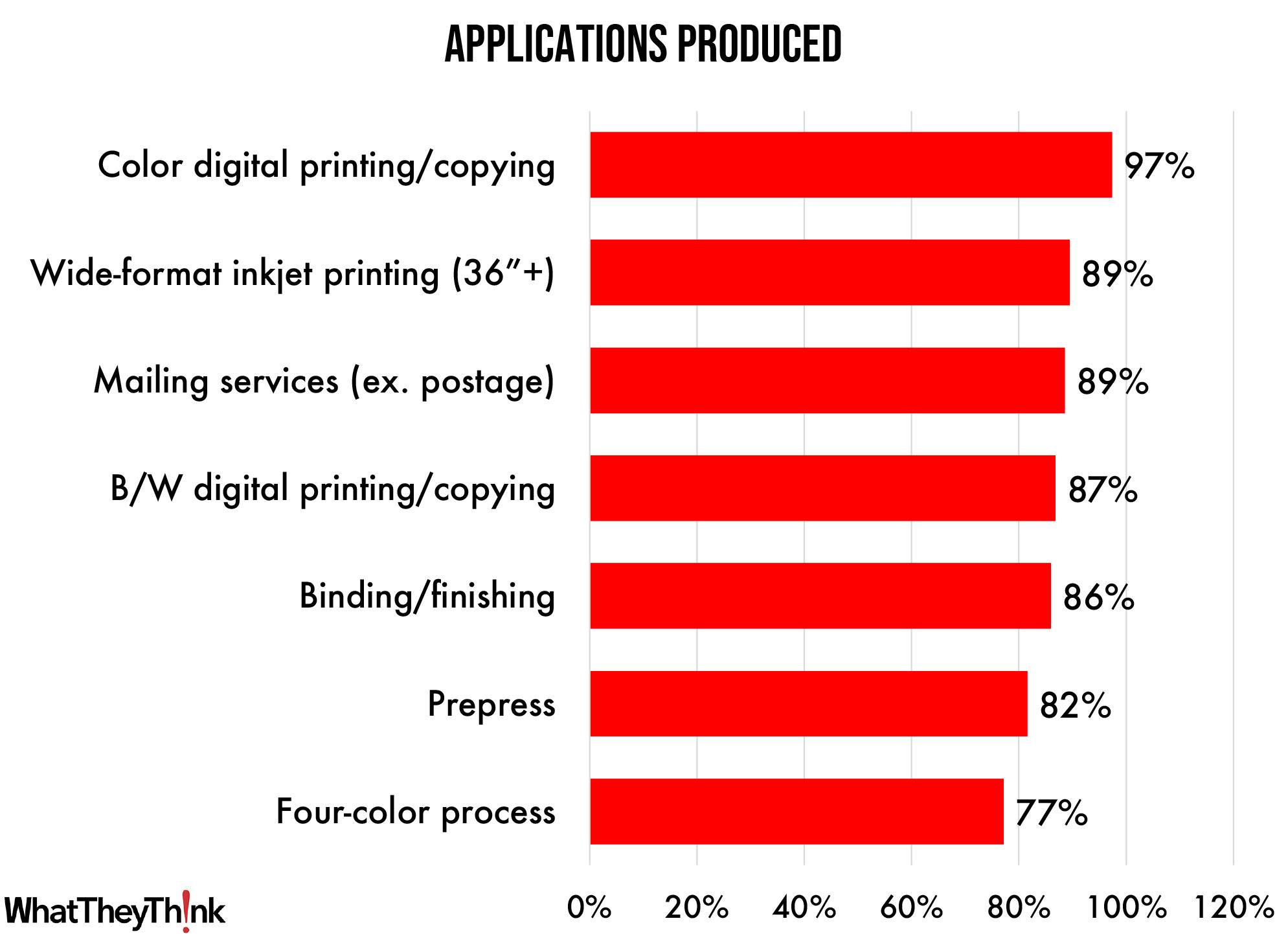






























































































































































































































































































































































































































































































































































Binding/finishing equipment has been a perennial number-one investment in virtually all of the surveys we conduct, and has been the case since pre-pandemic. Here we see that it is still far and away the most popular investment category. More



































































































































than one-fourth (27%) plan to invest in additional space or a new location, and 21% are looking to invest in mailing software and equipment. A record low (11%) say they have no planned investments.








































































































































































































































































































































































































The top technology our “Top Shops” are looking to add in the next 18 to 24 months is high-speed production inkjet—22% said they’ll be adding this. Still, 40% said they have no plans to add, and we don’t expect that it’s a suitable technology for too many print












businesses the size of our “Top Shops,” although as vendors’ equipment portfolios expand and more “entry level”-ish units appear, the technology will have more appeal for smaller print businesses.

Allen Printing Company has been a regular fixture of our “Top 10” for at least the past five years, and this year finally moved into the number-one spot. Last year, they were number four, with 2021 sales of $19,950,000; 2022 sales represent a 22% increase.
“Last year was everybody’s best year everywhere across the board, and that just translated into everybody buying more and everybody stocking up on more,” said Paul Heffington, COO of Allen Printing Company. “We had a very strong, robust economy last year. We picked up a few accounts, because we had a lot of stock on the floor that some other companies might not have had. So we tried to strategically place ourselves based on the previous years’ shortages and just make sure that we were ready to take whatever order came across our plate.”
Founded in Nashville in 1931 by the eponymous Mr. Allen, Allen Printing has been a family-run business since its inception. Mr. Allen transferred the business to longtime employee Howard “Bunkus” Crump, who then passed it along to Crump’s step-grandson, Tony Pack. The company was then transferred to Pack’s daughter, Shannon, and her husband, Paul Heffington, both of whom run Allen Printing today. The company is still based in Nashville and has grown to 130 employees. The company’s web header reads “Workin’ Hard and Bein’ Nice since 1931”—an indication that they place customer service above everything.
Allen Printing produces “a little bit of everything”—direct mail, financial printing (the ads and legalese like company credit card statements),
consumer products, as well as collateral materials, such as business cards and letterhead. All of these products boomed in 2022.
“It just seemed like everybody overbought or at least felt like they needed to overbuy because they didn’t want to get caught with their pants down,” Paul Heffington said.
Unfortunately, that overbuying meant that business slowed down going into 2023.
“What I’m hearing from our end customers is that they stocked up on inventory assuming that things were still going to be difficult to get for a while, and as the economy slowed a little bit, they kind of found themselves with a little bit of a glut,” said Paul Heffington.
He now sees buying patterns returning to normal.
When I spoke with Paul Heffington back in 2020 (they had been the number-five small commercial printer based on 2019 sales), it was the height of the COVID pandemic. Allen Printing’s strategy during that turbulent time was staying in touch
with customers and being nimble and flexible enough to take on whatever work is needed, while trying to figure out what “normal” was going to look like.
“It kind of made everybody in the industry—in all industries, not just printing—have to be creative on how they do things,” Paul Heffington said. “You have to do things a little bit different as far as building larger inventories of stock and trying to purchase a little further ahead, just to make sure you’re prepared. Part of being in business is you figure out how to jump that hurdle and keep on moving. When another one pops up, which will be totally different, you try to do the same thing.”
One challenge that has remained is consumables prices— especially paper—which Paul Heffington fears may turn customers away from print.
“It was such a sticker shock for the end customer, and what I’m afraid of is that’s going to push people out of print and into more of an online or digital format.”
The other big industry challenge—employment—also had an impact.
“Luckily, we maintained our core of people and have not really lost anybody,” he said, “but as we did have that growth and as we picked up new work, it was extremely difficult trying to expand our staff to accommodate that.”
The solution was a lot of overtime and getting creative with shifts.
“The shortfalls we had in being able to hire were picked up by our core group and we made sure that we maintained good customer service and were hitting due dates.”
Allen’s growth strategy over the decades has been to listen to their customers and expand their abilities to accommodate what they’re asking for. Part of that approach this year involves some strategic acquisitions.
“Not necessarily other printing companies,” said Paul Heffington, “but service companies that we would use to enhance our product, or finishing companies that would help us finish our products. We’ve decided to go out and purchase some of those and bring them in-house so we have more control, and we now have widened our footprint of what we actually offer in-house.”
The Heffingtons will share their 2022 success story in our “Top 100 Small Commercial Printers” webinar on Aug. 23. Register at whattheythink.com/top100.
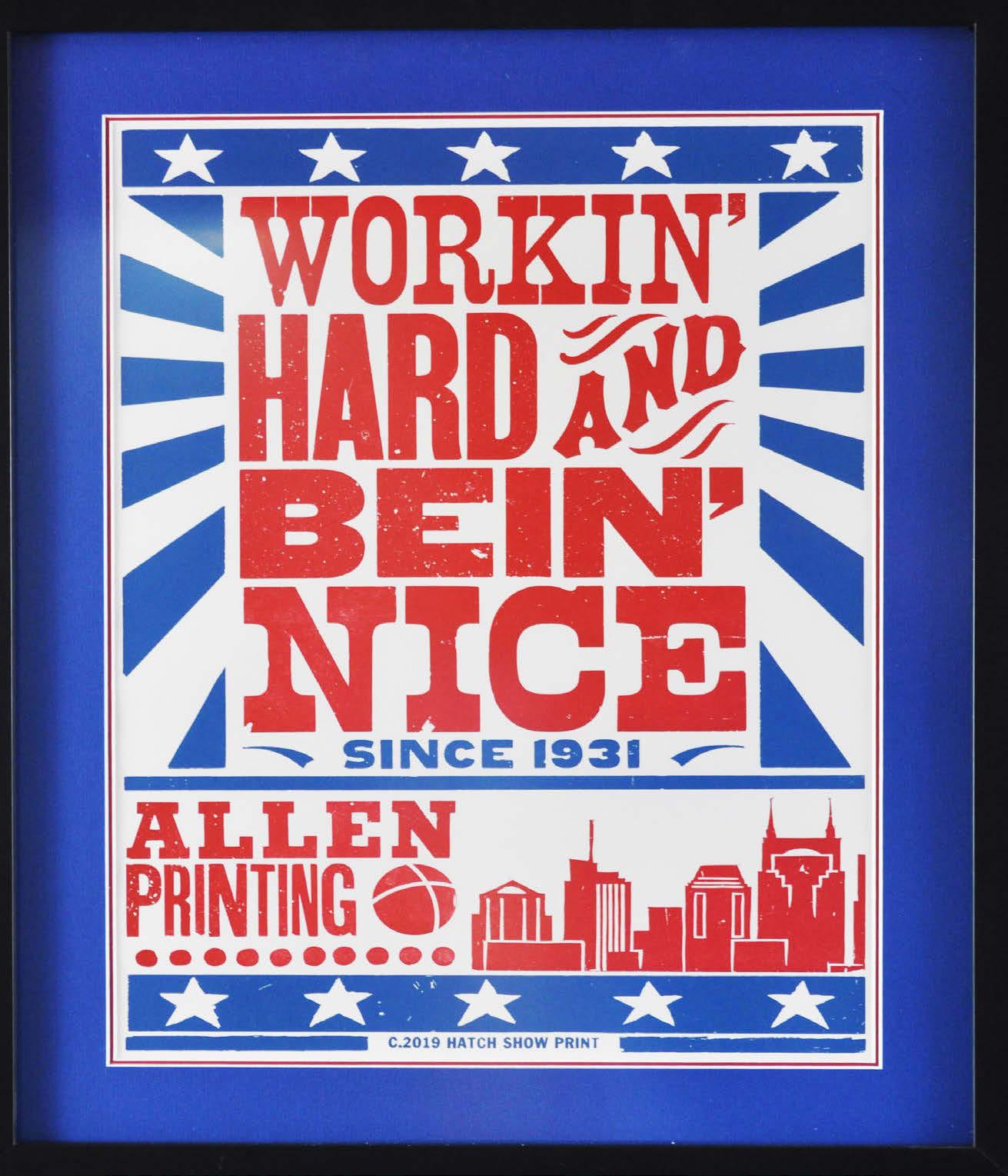
2022 was truly a recovery year after a very difficult business environment during the pandemic. Nowhere was this more evident than in the franchise networks serving the printing and sign/display graphics industries.

While most pundits will tell you that, in many markets, print is contracting, these franchise organizations have been able to overcome that prediction. And it’s not just that 2021 was such a bad year that double-digit gains meant getting back to 2019 levels—for many of them, 2021 was actually the recovery year, and the gains in 2022 demonstrate real growth.
One caveat,
According to data from a recent presentation by M&A firm New Direction Partners, the industry averages 12.3% in price increases to offset inflation.
As Dr. Joe Webb used to always point out, inflation adjustments are important in analyzing financial results. That being said, kudos to these organizations
for navigating through tough times, and coming out ahead on the other side. That’s not to say that these organizations haven’t faced a few challenges.
“The biggest challenge for the last three years has been staffing, getting good employees,” said Nick Titus, president of Minuteman Press International, “Once we do, it’s easy to get them up to speed, but finding people has been challenging, kind of the modus operandi for the last few years.”
One of the stressors during the pandemic was supply chain issues. That seems to have abated somewhat.
“If there are any minor issues out there, the owners have figured out how to work around them and how to work with the customers,” Titus said.“ It’s all about managing customer expectations with their jobs. So if you know that there’s a certain item that’s not available, they have figured out how to talk to customers about that and give them different options to still make them happy and give them what they need.”
This year, WhatTheyThink did not conduct its usual detailed survey of the franchise networks, but rather, asked for topline numbers, including network sales, growth over the previous year, and total number of centers, including how many net new there were. In addition, we focused on what they are doing along the lines of leadership development: How are the franchisors helping their centers build bench strength and bring along the next generation of leaders in their businesses. In light of the ongoing tight labor market, we believe that this is a hugely important aspect for their future success, including being able to attract and retain quality employees.
That being said, here is a summary of the topline performance numbers for each of the networks. We are also making available video interviews with executives in each of the networks that contain more detail.

In January 2023, Ray Palmer took over as Chief Operating Officer for Alliance Franchise Brands to establish greater alignment across all brands within the franchise, including the print, sign and direct- mail advertising businesses. Palmer said that the print franchise operations delivered about an 18% year-over-year revenue growth in 2022.
“That was on top of another strong year in 2021,” Palmer said. “We’ve recouped all the losses that occurred during COVID, and we are back on the plus side. Our sign business had already gotten back into positive performance in 2021, exceeding 2019 levels, and saw nearly 10% addition-
al growth in 2022. The number of centers for both brands decreased slightly in 2022.”
In terms of challenges, particularly on the print side, paper and envelope shortages were a problem.
“Finding paper was a major effort not only for our franchise members, but for the home office team as well,” Palmer said. “ We’ve also changed our operating philosophy; in the past we didn’t keep a lot of inventory because paper was always available. Now inventory levels have increased so we have the paper to produce product.”
He said that there were also challenges in acquiring some substrates on the sign side, and because many of the materials are petroleum based, rising costs were also an issue. Adjusting pricing at the franchise level to ensure strong margins was a key effort for the organization.
Palmer also cited staffing shortages as an ongoing challenge, as well as the lagging impact the pandemic had on owners and staff.
“The pandemic took a lot out of them, and many are ready to retire,” Palmer said. “ I see this as kind of a mirror image of what happened in ‘The Great Recession,’ when the impact was really felt a couple years later, in the 2010 to 2012 timeframe. But we are working through those challenges and refocusing our development efforts. We are very optimistic about getting things back on track and moving forward.”
In terms of opportunities, Palmer said that they have worked hard to get franchise members to focus on the basics of the business—customer care and making sure they are a partner and not just a vendor.

On the recruitment front, the company recognizes the stresses of the pandemic and beyond, and realizes that it’s not just them, but the entire industry.
“With almost 35,000 independent printing companies in the U.S., there’s an opportunity for us, because many of these people are feeling the same stresses our franchise members are feeling,” Palmer said. ”So we are looking at creative ways to do mergers and acquisitions for those motivated sellers. In 2022, we doubled our goal on the number of acquisitions our members completed. That adds more business to their portfolios without adding cost, and it’s a great path forward.”
Alliance Franchise Brands has a variety of programs in place to encourage new franchisees, whether they are an independent looking to join, an industry veteran wanting a different opportunity, or an entrepreneur who wants to start a new business. In many cases, entrepreneurs are able to acquire an existing business and not have to
start from scratch. Their MatchMaker program works to match independent entrepreneurs with independent print owners who want to sell.
The company is also focused on succession planning, both at headquarters and in the centers, assessing candidates and providing the extra skills they might need to move into a new role.
“We want to cultivate high talent individuals, move them into positions of authority, and grow them within the organization,” Palmer said. “Our center leadership development program helps to get the next generation of leadership trained and ready for the next step in their career.”
AlphaGraphics
AlphaGraphics’ CEO Ryan Farris reports that 2022 was a record year for the network, with average store sales of $1.3 million, average EBITDA of 14.9% and a 23% increase in sales. The network added 12 new locations and 17 new owners, including transfers. The network reported $307 million in systemwide sales across 275 centers worldwide (240 in the U.S.).
“2022 was a really good year, especially coming out of the difficult pandemic years,” Farris said, “and it’s great to see that we are still growing this year, holding strong and continuing to add value to the market.”
The network was also named a 2023 top franchise by Franchise Business Review, ranking 40th in the “large”category, which includes franchise systems with 170 to 399 units. They also received recognition for being “recession proof,” and was named as one of the top business services franchises.
As with most businesses in the printing industry, AlphaGraphics faced supply chain and hiring challenges, with those constraints continuing to carry over into 2023.
“The supply chain is beginning to stabilize somewhat,” Farris said, “but labor challenges continue. The unemployment rate is at record lows, and a lot of companies are hiring, creating even more demand on the tight labor pool. Even though we got more efficient during the pandemic, with better technology and more cross-training, you really need the workforce. We have leaned in on other areas, not just looking for trained professionals or existing seasoned professionals, but working on better training, recruiting more at those entry level positions, and then building them up. We’re starting to see some results from those strategies.”
Wide format is its highest growth segment, representing about 25% of revenues.
“We are also seeing a resurgence in cut-sheet color, and even black and white,” Farris said, “but it’s not outpacing the continued demand for wide format.”
Coming out of the pandemic, AlphaGraphics pushed out three key initiatives including a more dynamic national ordering system.
“Today, all of our centers offer web-to-print capabilities on a customer-by-customer basis, but
you can’t just route work through anywhere in the network,” Farris said. “We did a great partnership with Canva for some of the design components of templates. And all of the AlphaGraphics production and pricing will be available this summer across the entire nation. Work will be routed to the closest production facility. We will also be offering a national accounts program for large organizations that want the purchasing power but also want to tap into the AlphaGraphics network as a whole. Also, there is a ‘Buy Now’ capability that gives us 24/7 ordering.”
AlphaGraphics also continues to invest in its digital marketing solutions, with additional capabilities and partnerships.
In terms of the recruiting challenges, Farris said that AlphaGraphics is working to build a much stronger presence among universities and trade schools offering printing curriculum, as well as high school and other trade programs, including internships.
“We’re emphasizing the fact that it’s not just the physical printing, but also digital marketing, which has been a nice way to bring in a wider range of talent. We are looking for that young, emerging talent that is interested in a career path in the print and marketing space.”
The network’s Discovery Days events have also been effective in recruiting both employees and new owners. HR tools for the entire network have been updated, there have been increased investments in digital learning platforms, and the company has built out job pathways, literally taking people with no knowledge of the industry through a series of very short instructional-based videos with relevant content and testing for sequential job learning in bite-sized components. This takes people from zero to 100 over the course of anywhere from two to eight weeks, depending on the role
“2022 was a really good year, especially coming out of the difficult pandemic years,” Farris said, “and it’s great to see that we are still growing this year, holding strong and continuing to add value to the market.”
and job function. AlphaGraphics also utilizes the learning platforms offered by its vendor partners.
“It’s not just putting ink on paper,” Farris said. “You are actually helping businesses grow and gain employees. We typically touch and support more than 100,000 businesses per month. And we make it clear that the job someone is hired for is not a job for life; but rather, they have a clear career path that can ultimately lead to a management position or even someday owning multiple AlphaGraphics centers.”
Fortusis is the smallest network of the group we cover. The network ended the year with 34 centers, down three from the year before. Nonetheless, systemwide revenues were up 11%. During 2022, Fortusis rolled out new branding for its Kwik Kopy locations and added a new brand for the larger centers, KKP.

“This helped us to really focus on what our core competencies are inside of our system, and our larger locations really benefited from the KKP brand,” CEO Curtis Cheney said. “Also, 2022 was the first year we actually have had all of our centers on a single website. That was a really big ordeal for us to get all the centers on a single platform. But that move has shown itself to be successful over the last year. The branding and the website were our two big initiatives for the year.”
In terms of opportunities for the network, the consolidated website was a big one.
“They now have an ecommerce enabled website that reflects the new branding, and we are adding products pretty much daily,” Cheney said. “We have nearly 1,000 products on the website; each center can choose the ones that make the most sense for their businesses and their customers, while making sure pricing is correct. So it’s ongoing work that we are putting in to continue to develop it and make it even more functional. They can leverage capabilities from other centers, and we have quite a few outside vendors connected via APIs for outsourcing.”
In terms of challenges, Cheney said that paper shortages are easing up, but the network is still struggling with envelopes. Unlike others, they don’t have much of a challenge finding and retaining employees.
“Most of our centers are well staffed,” he said. “I think it’s just regular turnover, but we don’t feel like we are struggling to find the right staff.”
Looking ahead, Fortusis is planning to implement a new nationwide training system based on a learning management system, which already contains more than 20 hours’ worth of on-demand video training, with a goal to increase that to 60 to 80 hours during 2023.
In terms of bench strength, Cheney said that ownership of the majority of centers is slowly
starting to convert to owners in their 30s, 40s and 50s, although he said that the oldest owner is 90.
Fortusis continues to recruit for new owners and new locations.
“We are working with two right now that we hope will end up being new locations,” Cheney said. “While it has been a challenge to get individuals interested in our franchise, I think we are making some headway. The more we get involved with the website and training, the more we will be able to attract some of those individuals interested in joining a franchise.
“In addition, we are planning more frequent visits to all of our locations, with our Vice President of Operations and myself looking to spend a number of days in training our centers at least once every 18 months. That will also help us see what is needed at the different centers and address those needs.
“As we approach the sixth anniversary since our purchase of the franchise system, we are encouraged by our progress. We may be the smallest franchise system in this survey, but we are pleased that our reorganization is going well, and that we have a roster of good center owners who have embraced our recent changes.”
Rich Lowe, COO at Franchise Services, reports that systemwide revenues were up a little over 20% year over year in 2022, with sales right around $200 million.
“The average per franchisee is still right at a million or just slightly over that,” he said. “We saw ongoing increases in revenues of about 20% for the first quarter of 2023, as well.”
Lowe admits that part of this topline revenue growth can be attributed to the 15% to 20% price increases owners have levied, mostly due to increasing paper costs.
“The events business has come back in a big way, and our sign business grew last year at 26%,” Lowe said. “At Franchise Services, the sign business accounts for about 25% of revenues.”

Franchise Services has 195 locations, with two new centers opened and seven closed.
“When I started here,” he said, “There were 800 locations, so it basically reflects the printing industry as a whole. We’ve had a fair amount of atrophy over a long period of time, but the people who are still in business are really good operators, and we had about a 95% renewal rate for franchises last year. So overall, we’re pleased.”
He also notes that in a recent presidents’ survey, the headquarters operation received a 96% approval rating.
“We’ve never had anything that high before,” he said. “I think during COVID they really realized how much we help them.”
In terms of challenges, Lowe said inflation that drives cost increases, and of course, labor issues.
“We have a weird phenomenon now,” he said. “Franchisees have more money in their pockets than they’ve had in ages, for a couple of reasons. One is the money they received during COVID. But the other side is they can’t get people, and their businesses are coming back. That’s our number-one issue.”
He also cited government regulation on franchises.
“The current administration is really putting a stranglehold on franchising, and I’m extreme-
ly concerned about that going forward. This includes the National Labor Relations Board’s move to change the joint employer rule.”
Lowe also cited cybersecurity issues, ransomware and data privacy issues.
In terms of applications, Lowe reports that mailing services is their second fastest growing product, behind signs.

“It’s a little surprising,” he said, “since there are so many people still working from home.”
The franchise also introduced new logos for all of its brands.
“I told our marketing team that I didn’t have an interest in changing our logos if they are not going to add to our differentiation in the marketplace. So we spent a lot of time talking about the direction our business ought to go and looking at major influences in the business world, as well as the play that customer experience is getting. In addition to the new logos, an increased focus on customer experience came out of that work.
Franchisees are taking a critical look at their operations to see how to take friction out of doing business with us, from answering the phone and billing to delivering on time. We’re trying to sand the stone a little bit to make sure we are doing a better job of supporting the end customer.”
In terms of hiring challenges, the network uses a tool called CareerPlug.
“It improves the hiring process for our franchisees,” Lowe said. “With the changes in the labor market, they need to change their mindset, from it being a benefit to have a job, to ‘I want to be an employer of choice.’ The image of the industry also affects recruitment. We want people to see we are a cool place to work and to do business with. We have unique technology. We help customers on a daily basis. We have many projects that are fun to do. So we have to position ourselves in a different way.”
To build bench strength, Franchise Services has the NextGen training program, teaching second generation or other managers of a franchise location how to business plan, hire and fire, and show leadership.
“People buying Franchise Services businesses today don’t come from the manufacturing side, but rather, they are entrepreneurs or on the marketing side,” Lowe said. “Our locations look really sharp. There are people moving around as a team. One center I visited recently only had one person over 30. So the business is really changing, and we need to get that word out to the market. I’m enthusiastic about the future of our business.”
Minuteman delivered systemwide sales growth of about 21% year over year, according to Titus, from 2021 revenues of $442 million to 2022 revenues of $537 million. The organization has added 24 more centers over the past two years, including 13 net new stores in 2022. As these stores come up to speed, one could imagine that systemwide revenue increases will follow. Minuteman has 972 locations worldwide as of this writing.
“We had the largest system-wide gross sales that we’ve ever had, and many stores had record years, record months,” Titus said. “It was excellent performance; tough to keep up with, but that is a good problem to have.”
In fact, Titus said about 125 of its stores generated revenues in excess of $1 million, qualifying for the company’s Presidents’ Club meeting.
Minuteman provides its centers with a series of shorter, more targeted training videos that enable faster onboarding of new employees while freeing the owners to work on building their businesses.
In 2021, the company also launched a new website, minuteman.com, featuring online design and ordering capabilities.
“That has been very successful,” Titus said, “and we are continuing to add more user-friendly features to the site that will streamline the ordering process for our customers,
“This is something that my grandfather instilled in all of us, and we passed it down to the owners themselves over the years: You can’t move up within a company or organization unless you train someone else to do your job. Cross-training employees is critical although it has gotten a lot easier with more automation. We’ve put a focus on that. Most people who are motivated want to continue to learn and get better at their jobs. It’s kind of a two-way street: we do provide the tools, but the employees also have to have the desire to continue learning.”
One aspect of this for Minuteman is more training at all levels on the company’s proprietary operating software, Flex.
“This includes cross-training employees on different parts of the business, including pricing, which 20 years ago was primarily the owner’s job,” Titus said. “Now there are people throughout our stores who can handle pricing, as well as other functions that they were not privy to in the past.”
Some local Minuteman centers have been in contact with universities and trade schools in their areas to attract new talent.
Each year when we do the franchise review, we wonder how smaller independents continue to survive in a highly fragmented and competitive environment.
Independents don’t have the kind of infrastructure support that franchise networks provide, including technology assessment, help with hiring and training, marketing, and the ability to leverage other centers in the network.
As we noted last year, independents primarily seem to object to paying fees to the franchisor. However, these fees are often less than one fulltime equivalent, and the services headquarters provide can be accessed on an as-needed basis, rather than hiring several people to do work that may not require a full-time person in each role, especially in a smaller shop.
The value of being part of a franchise network was clearly evident during and beyond the pandemic.
“I can’t imagine going through COVID without the resources to navigate all the government changes and the funds that were available,” Palmer said. “We were able to do this for our members because we have real-time data coming in from the centers, enabling us to provide real-time guidance so people could make the right decisions in a timely fashion. Our members really recognized that was a true benefit of being part of the organization during that difficult time, because we did it for them, and they could focus on maintaining their businesses.”
We caught up with Francis McMahon, executive vice president at Canon Solutions America, Production Print Solutions, who spoke about his leadership style, how he came to adopt that style, what being a “corporate hippie” means, and how he is helping the next generation of company— and industry—leaders.
At the thINK keynote last year, you spoke about leadership and your leadership style. In particular, you talked about the company as the “Magic Bus.” Could you explain what you meant by that and how that informs your leadership style?
The concept of the “Magic Bus” is pretty important because it’s all about our decision to get on the bus or not. Nobody’s forcing anybody to do anything, but there has to be a belief that, when you get on it, you know that the person driving the bus has an idea of where they’re going. They’re not just going to drive around in circles. Everybody on the bus plays a role in getting to a final destination. But it’s not really about the final destination—it’s about the journey and all the things that you develop and share throughout that journey. You’ve got to be in it together, and “on the bus” together.
So the company is the bus and the people who work for the company are the people on the bus.
Right, and that relates to the people are in your organization, the people you work with. You want to make sure they are tied to the mission. And the way to do that is, instead of telling them what the mission is, make sure they’re a part of developing that mission, having them be a part of the creation of the mission. You have to get people excited about where you’re going, and they have to feel like they can contribute, that they know the role that they play is important.
Somebody’s playing the part of the driver, somebody’s reading a map—we all have critical roles. But the bus is important because if you go back in time and you read about Ken Kesey’s “magic bus” called “Further,” it was individuals that all felt like they could make a very significant change in the world. But it wasn’t any one person who could do that. So that’s where the “magic bus” comes from.

WTT
You describe your leadership style as “transformational.” What do you mean by that?
FM
Transformational means always looking for new or better ways of doing things. The mind has dimensions. It’s a bit like, the universe has all these galaxies and we keep finding new ones— there are new things being discovered all the time. I think the mind is the same way, and the role of a leader is to help people break through each dimension in their mind so that they can become
FMmore creative and more confident. A lot of people don’t know what they’re capable of doing, or they’re not confident enough to explore it. If you can help them break through these layers, every time you get through a new layer, they become even more confident in and competent at what they do. Before you know it, you’ve allowed them to go off and create something on their own because there are no risks. You’ve broken through boundaries, and then they come back to you with amazing ideas. And if you’re willing to listen to those ideas, it can really change your company.
Canon has led inkjet market share for the better part of a decade, and we’ve got very low turnover. We make our numbers every year, and to
me, it’s no secret as to how. It’s all these people who are just so committed to being on this bus together, and they all recognize that they’re capable of doing things they probably never thought they could before.
So, yeah, if I had one word to describe my leadership style, it’s transformational. And it didn’t start that way. I had to learn that, and it was from being surrounded by other great people who showed me the way.
Who were some of those people and those things that got you to where you are today?
FM

I graduated from San Francisco State, and I got my first job with Kodak as a copier salesman. I was very excited, but I didn’t sell one thing for nine months. Imagine being a young kid on his first job and having zero success. Your confidence goes down. But I had a manager named Vicki Weiss who, every single day, told me how good I was, that it was going to happen. I was doing all the right things, and if I just stuck with it, it was going to happen. Without that, I probably would’ve given up, and my career would be very different today.
And, lo and behold, in the ninth month, I became the number-one sales rep for the month. I still keep the award in my drawer here at Canon as a reminder. I ended up making my quota that year.
What I learned through Vicki was that you have to show a level of compassion. You have to show people that you believe in them—assuming you truly do. And you have to encourage them. And if you do all of those things, they’ll feel valued, they’ll be inspired, they’ll put the effort in, and more than likely they’ll be successful.
We have a broader calling to provide a level of inspiration to all the people around us. It’s contemplating what is important and what it is I need to do when I step into my role today. It’s not about the list of “action items” and attending all these meetings. It’s about how I’m going to walk through the
halls here and let people know what’s possible, that we can get there, and get them excited. Being inspirational to the people we interact with every day is really the job that all of us, as leaders, need to have.
You’ve probably also had managers in the past who were the exact opposite of Vicki. Did you learn anything from them?
FM
I have. One in particular was not a compassionate leader, not someone that was going to tell you you were doing a great job. He had a very different approach, which was more about the need to have an aggressive plan and to make sure we’re all committed to the plan. Everybody needs to know very thoroughly what role they play, how they play, how they’re measured. I hate to use the word, but he was very “transactional” in his leadership approach. This guy completely shaped the way in which I go about leading the organization from a more disciplined approach. And I was very fortunate to work with him for a number of years. So if I had to pick two people who influenced me the most, those would be the two.
WTT
In the background of your Zoom screen, there is a pillow that has “Corporate Hippie” embroidered on it. What does that mean to you?

FM
In high school, I was called a “preppy hippie” because I was running around seeing a lot of Grateful Dead concerts and had very long hair, but I also played three sports and I always had an alligator shirt on.
“Hippie” means different things to different people, but what it means to me is creating a culture where everybody can be happy. Everybody is doing the things that contribute to the broader group. There is no selfishness; everything is selfless. That’s part of being a really good leader. It can’t be about you; it has to be about everybody else. It’s about delivering happiness to people and wellbeing and functioning in a way that’s doing the right thing above all else. So I took that into the workplace and created a culture here based on those values.
In your thINK keynote, you said “drop the title and be one with your organization,” that leadership isn’t necessarily about one’s job title. Obviously that’s your functional role, but at the end of the day you’re the bus driver.
But also recognize that you don’t always have to be the bus driver. Sometimes you have to get up from the driver’s seat and give it to somebody else who’s much better at whatever the current topic is, or they have another idea, or they could do better leading a certain meeting. Another part of being a “corporate hippie” affects the way I’m dressed. It’s purposeful, meaning I don’t want to look different from everybody else. I want to be with them, not different from them. There used to be special parking here for executives—is it really that far of a walk? Do you really need to have your own spot?
Why should I get a premium parking spot when the person who’s working three extra hours every day trying to figure out our marketing or working on a technical issue should probably get it?
How do you see mentorship from the standpoint of being not only a vendor, but also from that of a print shop owner?

First off, you have to care. And if you don’t, recognize that you don’t and give the responsibility to somebody else. But you have to care about people, you have to care about the organization. I also care about the industry. I feel a real responsibility to grow the industry, and I can’t do it on my own.
The mentorship part is you have to help people find that fire as well, that commitment to really care about the industry. You’ve got to select the people that really want to be mentored or don’t know they want it but have the potential to be future leaders, to take our company further, and take the industry further. You have to make the time for it and to show a level of compassion when you tell somebody, “Look, you’re worth investing in. You’re worth my time.”
There are also the people that you’re not quite sure if they deserve the time, but if they come to you and request it, give it to them, and if they respond to it, great. If not, end it quickly because it just means you’re taking time away from somebody else that you could mentor.
I think people who are in “title” roles, especially those who are in a certain demographic—my demographic particularly—you’ve got to sit in the backyard with that cup of coffee and think about what’s most important. And what’s most important is growing this industry, which means you’d better go spend some time with people.
And mentoring doesn’t necessarily mean just one-on-one time, but putting people in roles where they’re getting exposed to the broader business, getting them in front of customers, in front
of finance, including them in staff meetings. The other part goes back to compassion. You have to know a person’s individual situation. How do you help them be successful at their job while taking into account family obligations? How do you mentor them? And then how do you make sure they’ve got a life where it all comes together in a really wonderful way?
We tend to get up in the morning, look at the calendar and to-do list, and forget about what’s really important. And we have to remind people about that. If we do that, we’ll have the next generation of leaders ready to go. So when I look back when I’m 75 years old, I can smile and say, “Wow, look at what they’ve done and continue to do.”
“Somebody’s playing the part of the driver, somebody’s reading a map— we all have critical roles.”
While I have been blessed with some really great managers over the course of my career— both in and out of the print industry—I have also had my share of really awful ones. I recall one CEO in particular who would regularly swagger (yes, swagger) into the office and declare: “I’m in the mood to fire someone today,” after which he’d head to his office. It didn’t take long before HR was in there, too. And sure enough, by the end of the day, some poor soul was sacked.
And if you’re wondering…yes, I was once that poor soul who got sacked. Good riddance!
According to a Gallup study, organizations with engaged employees have 41% lower absenteeism and 21% higher profitability than those with disengaged employees.

A good manager is someone who can lead with both authority and empathy. They know how to delegate tasks effectively and manage a team to maximize productivity and efficiency. Good managers understand the importance of communication and foster productive conversations between themselves and their employees or direct reports.
A good manager reflects a good team. There are no egos, the team thrives with each supporting the other, and everyone—particularly the company—reaps the benefits.
Bad managers fail to lead their teams effectively and foster a negative work environment. They don’t take the time to get to know their employees or provide clear direction and expectations. They fail to recognize and reward good performance, taking full credit for other people’s efforts—and shifting full blame rather than take responsibility for mistakes made or poor results. As a result, employees become disengaged, morale drops and productivity (as well as the bottom line) suffers.
There are many traits that define a good leader. Here are five important qualities that I believe are essential for effective leadership—and the stats to back them up.
A good leader has a clear vision of where they want their organization to go and how they plan to get there. They are able to articulate their vision to
Maintaining well-being elevates your leadership potential. By Joanne Gore
others and inspire them to work toward achieving it.
According to a study by Deloitte, 94% of executives believe that having a clear vision and purpose is important for effective leadership.
Communication is key to effective leadership. A good leader is able to communicate their vision, goals and expectations clearly and concisely to their team. They are also able to listen to feedback from their team and incorporate it into their decision-making process. A survey by Interact/Harris Poll found that 91% of employees believe that effective communication is the top attribute of successful leaders.
A good leader leads by example and sets a high standard for ethical behavior. They are honest, transparent and trustworthy in all their dealings with others.
According to Edelman Trust Barometer, 76% of employees believe that ethical leadership is the most important factor in building trust within an organization.

A good leader is able to put themselves in their team members’ shoes and understand their perspectives. They are supportive and caring toward their team members and strive to create a positive work environment.
Research conducted by Development Dimensions International (DDI) indicates that leaders who display empathy are more likely to have engaged employees, resulting in a 40% increase in discretionary effort.
A good leader is able to adapt to changing circumstances and make decisions quickly when needed. They are able to navigate uncertainty and complexity with ease and maintain focus on their goals.
A global leadership study by Korn Ferry found that 90% of high-performing leaders demonstrate strong adaptability.
Good leaders motivate their teams by creating a positive work environment that fosters creativity, innovation and growth. They provide their team members with the tools and resources they need to be successful and recognize their achievements and contributions.
They instill confidence in their team members by leading by example and being accountable for their actions. They are transparent and honest in their communication and create a culture of trust and respect within their organization. Here are five ways to achieve this.
A study by Harvard Business Review found that companies with effective leadership were 90% more likely to have engaged employees than those without.
To become a great leader, seek out opportunities to develop and hone these essential qualities. Through refinement, continuous learning, self-reflection and practice, individuals can become successful leaders who inspire and empower their teams to flourish.

As a health and wellness coach and certified fitness instructor, I have firsthand experience in how prioritizing self-care can elevate leadership abilities and the profound impact that maintaining well-being has on our capacity to lead effectively.
One of the cornerstones of effective leadership lies in our ability to make informed decisions and think critically. Remarkably, maintaining well-being significantly enhances these cognitive capabilities.
Employees who engage in regular physical activity witness an incredible 22% increase in their
Good leaders recognize their team members’ achievements and contributions and celebrate their successes.
Support
Good leaders provide their team members with the support they need to be successful, whether it’s through training, mentorship or other resources.
Good leaders provide constructive feedback to help their team members improve and grow.
Good leaders create a culture of trust and respect within their organization by being transparent and honest in their communication.
Good leaders empower their team members to take ownership of their work and make decisions that support the organization’s goals.
ability to make complex decisions compared to their sedentary counterparts.
Exercise serves as an elixir for our minds, boosting cognitive function, increasing focus and creativity and improving problem-solving skills. As leaders, we must carve out time for physical activity to reap these cognitive benefits. Whether it’s a brisk walk, a yoga class or a cycling session, every form of movement fuels our mental agility, empowering us to make sound decisions even under pressure.
In the fast-paced business world, stress and challenges are inevitable. However, how we man-
age and respond to these pressures shapes our effectiveness as leaders. Maintaining well-being plays a pivotal role in cultivating resilience and effective stress management.
Workers who exercise are 33% less stressed and 46% better at dealing with stress.

Exercise triggers the release of endorphins, our brain’s natural “feel-good” neurotransmitters, helping combat stress and promoting mental well-being.
An article in the Harvard Business Review emphasized the importance of self-care and stress reduction in leadership development. Leaders who prioritize self-care, including regular exercise, quality sleep and relaxation techniques, experience a higher level of emotional intelligence, better stress resilience and improved problem-solving abilities.
Leadership is not just about personal achievements; it also involves fostering a positive work environment and inspiring others to perform at their best. When leaders prioritize their own well-being, they set an example that can lead to increased employee engagement and productivity.
According to Gallup, organizations with higher levels of employee engagement experience 21% higher productivity. By prioritizing our well-being, we communicate the importance of work-life balance and employee well-being. When leaders engage in self-care, they demonstrate empathy and concern for their employees’ well-being, creating an environment of support and trust that drives productivity and collaboration.
Employees who feel supported by their leaders are 30% more likely to perform at their best.
As a member of canfitpro, Canada’s largest provider of fitness education, well-being and leadership development, I’ve learned how incorporating regular physical activity into our routines can reduce the risk of chronic conditions, enhance mental well-being and increase overall energy levels.
When leaders prioritize their fitness and well-being, they amplify their ability to inspire and lead by example. By embracing a holistic approach to fitness, incorporating strength training, cardiovascular exercise, and flexibility routines, leaders can experience the physical and mental benefits that contribute to enhanced leadership capabilities.
Lessons learned from within the health and fitness industry have helped me to pinpoint obstacles, reframe mindsets and develop strategies for effective leadership. When looked at through a business, here’s how these traits apply:
Continue learning. First and foremost, accept that setbacks happen. Use them as learning opportunities and figure out how to mitigate them in the future.
Don’t let others control your destiny. Whether I was teaching aerobics or leading a WW (formerly Weight Watchers) meeting, I helped people set their own goals and achieve their own success. I was there to provide support, ask the tough
questions, and offer options and strategies that could be adapted to any level or situation. I use the same approach with clients.
Be an active listener. When you listen to hear, instead of listening to speak, you can start connecting dots, as you get a glimpse into how the other person thinks, feels and responds to situations. This arms you with valuable insights when the need arises.
Be kind to yourself. Treat yourself to what brings you joy, whether it’s an ice cream cone, a walk in the park or a round of golf. Reframe “cheat days” into “treat days.” Own your choices. Enjoy them. Celebrate them. But if your choices make you feel bad, or have negative ramifications, consider a different choice next time.
Life is full of U-turns. The world doesn’t come to an end when you make a mistake. If you have a piece of cake, skip a workout, or choose french fries over salad, all is not lost. But when one slice turns into a whole pie, and you haven’t gotten off the couch in a week, it becomes harder and harder to get back on track. Similarly, when companies make mistakes, it’s essential to recognize them early and set it right, before it gets past the point of no return.
Bite the bullet, face your worst fears, and get your feet dirty. Skipping out on workouts (or skipping out on meetings) sends a signal that you’re not committed to doing what’s necessary to hit your goals. When that happens, it’s time to re-evaluate your objectives—and your strategy.
Smile. There is nothing more powerful than the simplicity of a smile. I used to tell people coming to my classes to smile, laugh and have fun. It didn’t matter if they were going left and I was going right (as long as nobody got hurt!). As long as they remembered to breathe—and get out of their own heads.
Ask the right questions. There’s a big difference between: “How much weight do you want to lose?” and “Why do you want to lose weight?” The same holds true for business. “How many leads do you need?” is hardly the same as “What is the DNA of a lead?”
Stay true to yourself. Ethics, discipline, morals and process is a way of life, whether in fitness or your business. Consistency gets results.
Be patient. Change doesn’t happen overnight, but with passion and a hunger to excel, change does happen. Little by little, incremental changes in your body, much like your business, will shine through as you target new milestones along the way.
Incorporating physical activity into your routine strengthens your cognitive abilities, cultivates resilience, and promotes effective stress management. By leading a well-balanced life, you foster employee engagement and productivity, creating a supportive and thriving work environment.
Embrace the power of maintaining your well-being, and watch as your leadership capabilities soar. You have the ability to inspire positive change and empower those around you to reach their fullest potential. Embrace this journey, and become the exceptional leader you were destined to be.




























you become more successful.













The “Three Point Revolution” completely changed the game of basketball. The size of the court effectively doubled with no more players to cover it. And every existing playbook became obsolete. The same thing has happened to the environment in which your organization operates. And far too many playbooks have not changed at all.
I coach senior executives. Those coaching sessions always address significant challenges faced by the executive and the organizations they lead. And I see more than merely common threads—I see repeating and high-risk patterns. Those include anxiety about the performance of their organizations, frustration with the lack of engagement from staff, and awareness that past leadership skills and approaches are no longer effective.
We live in extremely challenging times. The military developed an acronym to describe this environment: V (volatile), U (uncertain), C (complex), A (ambiguous). VUCA. It sounds tough and ugly. And it is.
So first, let me ask how you are feeling. It’s not rhetorical. It’s a serious question. Its purpose is to start a serious discussion about individual and col-
lective well-being. This discussion has become necessary because research reveals multiple, dangerous realities including alarming levels of depression.
“The percentage of U.S. adults who report having been diagnosed with depression at some point in their lifetime has reached 29%, nearly 10 percentage points higher than in 2015,” according to recent Gallup research. “The percentage of Americans who currently have or are being treated for depression has also increased to 17.8%— the highest recorded by Gallup since it began measuring depression in 2015.”

We have also reached record levels of burnout.
“Sixty percent of employees report being stressed all or most of the time at work,” according to a recent Deloitte workplace burnout survey.
Additionally, some form of mental illness will impact one in four adults during their lifetime, according to Gallup research.
These realities lead to unhealthy and dangerous behaviors. Those include increasing crime, divisiveness, extremism and the loss of civility. These behaviors don’t stop at the door to your organization.
When what you’re doing is no longer working, it’s time for a new plan.
There are also unprecedented generational changes as Gen X, Gen Z and millennials become a greater percentage of our workforce and begin to assume leadership positions. This new workforce has a very different set of perspectives and expectations from their work experience.
How are these challenges and new realities impacting your workplace and enterprise? Recent Gallup research indicates that only 32% of U.S. employees are engaged in their work, while 18% are actively disengaged.
This leads to $322 billion of turnover and lost productivity costs globally, directly attributed to employee burnout.
Gartner Research shows that 68% of senior HR leaders reported managers are overwhelmed, while only 14% of their companies took steps to improve the situation.
Gallup research also shows four in 10 U.S employees believe their jobs negatively affect their mental health, and fewer than one in four believe their employer cares about their well-being.
Organizational leaders need a new playbook

that supports well-being, delivers for shareholders and stakeholders, and radically improves supervision and management competencies. We need organizational cultures that balance well-being and employee growth and development with investments in new technologies.
This is why I created the “Peak Performance Series.” It’s a fact-based introduction to the leadership skills and competencies required to achieve peak performance when the world is volatile, uncertain, complex and ambiguous.
The series focuses on six primary elements as the foundations for the “new organizational leader’s playbook.”
Here we define well-being: building a life of vitality, purpose, resilience and engagement. However, most importantly, it builds an irrefutable business case for investing in both personal and organizational well-being. It makes the case for hard-headed business leaders to stop ignoring this. Without basic health, wellness and well-be-
ing, individuals and organizations are sub optimized and never attain peak performance.
We then introduce Gallup’s “Five Elements of Well-being” and provide an outline to help you create your own plan to achieve greater levels of resilience, physical and emotional health, and overall well-being.
Here we explore 11 leadership competencies to create and maintain an organizational culture that builds well-being.
Then we pivot to define your personal purpose, which gives your life consequence, substance and lasting impact. We unpack a process to intentionally create and craft one’s own unique purpose.
Why must your organization exist? What are its core purpose, values and “adjacent commitments” that contribute to the well-being of stakeholders and shareholders? We examine the importance of an inspirational value that is carefully crafted and present in your enterprise mission and vision.
Here we explore the critical importance of actively and intentionally leading and managing employees. This session targets the extremely challenging and critically important role managers play in achieving peak performance.
Investments in hardware and software alone will not lead to sustained success. In comparison, only modest resource investments are required to create and maintain an organizational culture that supports and develops your human resources.

The program is available for free from APTech and WhatTheyThink at bigmarker.com/series/ peak-performance-series/series_details.
Proudly serving commercial printing, packaging, digital and wide format companies since 2002.


Members enjoy:
Savings on equipment, consumables, and services
Exclusive access to industry news and education
Top tier support from a dedicated management team
Learn more at:
GraphicArtsAlliance.com or call (215)710-0699 x104
 By Wayne Lynn
By Wayne Lynn
For centuries, leaders of all types have struggled with making good people decisions. Accomplishing the goals of any organization is impossible without people. When you look at what it will take to achieve an organization’s purpose, it becomes obvious that some people are more capable of helping with that than others. Why is that?
They have experience in similar jobs elsewhere, better knowledge that can be applied to the job and physical or mental skills that should help them perform the job better.
If you’ve had much hiring experience, you know that, despite these obvious advantages, a lot of the people you hire for a job still don’t turn out to be successful. Why is that? There is, at least, one more predictor of success that hasn’t been evaluated.
Look at it this way. The three qualifying factors listed above are an indication that a job candidate should be capable of performing your job from a mental and physical perspective. In other words, they can probably do the job. But will they, in fact, do a good job?
Since the middle of the 20th century, the science of psychology has developed the analytical
discipline called psychometrics, a way of identifying and measuring human behavioral factors. As an example, in the early 90s, Dr. Dan Harrison, an organizational psychologist, developed the Harrison Assessment system. It can measure up to 175 human behavioral factors. These factors are found in all humans to varying degrees. In addition, Harrison has analyzed over 600 occupations and identified each of their unique combinations of these factors.
Not only are the factors contributing to job success known for each of these occupations, but also the strengths of these factors can be measured. An actual numerical rating can be calculated that translates into the probability of success in a particular job. We refer to this as the suitability of a person for the job. The higher the score, the more suitable the candidate is, and therefore, more likely to succeed in the job.
Highly qualified candidates with low suitability scores will tend to struggle to succeed in the job. If you’ve done much hiring in your career, you have seen this happen. Most of the time we just scratched our heads and moved on to the next
candidate. Or we just settled and kept the ill-suited, poor-performing person in the job knowing it was hampering overall organization performance. Why settle? Mediocrity shouldn’t be considered an option.
The idea of assessing job-related behavior has been very slow to gain traction in many industries, including print and related industries, for a number of reasons.
Most of these companies are small, with two to 50 employees. The sophistication that comes with professional HR managers is absent. In large companies this technology is sold to the HR department. It is not generally sold at the C-suite level. Therefore, the natural “bridge” into these smaller companies does not exist.
Selling the benefits to the owner/CEO of the typical print company is difficult. They don’t have the time to deal with it. They may not have the caliber of people who can understand and use the technology.
Many of these owners look at the cost and don’t consider the bigger picture where the returns on investment will materialize. An assessment will cost up to $500 per average employee. The average won’t be that high, but some jobs will require it. This, on its own, is a lot of money that the average small company owner will struggle to justify.
The returns come from several things and are
perceived as “soft” and hard to measure. However, savvy business owners/operators know intuitively that the ramp up to desired productivity levels will come faster with new hires who are both qualified and better suited behaviorally for the job.
The bottom-line impact of saving just one month to full production is worth the cost of assessing three to four candidates to pick the best fit. It is poor practice to consider only one candidate for an open job.
The bottleneck threshold for this employee will be much higher than the poorly suited one. In other words, much more work will pass through this stage of the process per unit of time and reduce waiting in downstream work centers. Savvy operators understand and know the value of this.
Peer group impacts that other employees will feel and be motivated by will fall to the bottom-line also. Many people resist “stepping it up” until someone starts to put a light on it.
Smart hiring of new employees has a noticeable but subtle effect that some call “raising the common denominator.” As more new employees enter the company with high suitability scores, the cumulative impact is not manifested in the rise of a linear average of suitability scores. Higher scores follow a power law curve and start to accelerate geometrically. Depending on the average

“When hiring, don’t settle. Mediocrity shouldn’t be considered an option.”
suitability score at the start, what looks like a 5% rise in the average could be a 20–30% rise. This is a game-changing improvement in productivity and overall performance.
Note that everything here also applies verbatim to the process for making decisions on promoting internal candidates. The one caveat is that often there may not be three internal candidates to consider, but they should be assessed using this process to determine if they are behaviorally well-suited for the job they may be promoted into. It is important for your current employees to know they were considered for the opportunity even if they are passed over. It’s also a great chance to have a conversation about where they can improve to help the odds of landing the next opportunity.

Entrepreneurs who own and operate small
businesses and have everything they own “on the line” are normally skeptical of new things. They should be. They need proof—and lots of it. They don’t completely trust salespeople, consultants, trade associations, etc. If they are interested in new and untested ideas, technology, materials, equipment and methods, they will want to try it out experimentally (at no cost to them is preferred) or talk to someone they trust who has tried the new thing and liked it.
So where does this put us? As a leader, if you’re like most of us, you want to leave a legacy that you passed this way. I’ve discussed some of the ends and outs of developing that legacy in previous articles that have appeared online at WhatTheyThink.
You need someone on your level to talk to, especially when you’re swimming in cold, uncharted waters. So let’s create people-building peer groups. These consist of company owners who believe in finding, developing and keeping better people.
one Reduce hiring, promotional and developmental mistakes.
Two Help employees realize their full potential, grow as individuals and improve performance.
Three Learn to use a state-of-the-art behavioral assessment tool to improve culture, engagement and team cohesion.
Four Learn new approaches to human resources management, productivity on an employee-by-employee basis and productivity advances through employee development and growth.
Five Think about having a group of peers who can learn from each other and build more competent and productive workforces by pooling their learning and experience.
It’s lonely at the top
Since print is a complex series of interconnected processes, there are many areas that could be affected by sustainability efforts.
Truly sustainable development is defined as meeting the needs of the present without compromising future generations’ ability to meet their own needs. Sustainability reaches into every aspect of the printing business, from process, to people, to profitability.
Transitioning to digital print technologies positions printers to better manage lower run rates and market shifts, while providing them with better opportunities to create more complete print through finishing automation.
Online printers with automated workflows prove that even more production efficiencies and waste reduction can provide a solid base for continued growth in a more competitive environment.
The printing industry is continuously introducing new regulations to support sustainability, compelling organizations to recognize and follow trends as environmental, social and governance (ESG) criteria are factored into company modernizations, and which socially-conscious investors are using to screen potential investments.
Printed products are varied, as are the processes used to create them. The focus on design, production, use and disposal of these products
will continue to be scrutinized in the context of a circular economy as environmental pressures increase. This will foster further development of green printing products and processes. However, each of us has a responsibility to address our individual processes. In the end it really has to be all of us if we want to stabilize and turn things around for the planet.
The most often quoted definition of sustainability comes from the UN World Commission on Environment and Development: “Sustainable development is development that meets the needs of the present without compromising the ability of future generations to meet their own needs.”
We have been operating a linear economy, or a process labeled “take-make-waste,” in which we take resources from the ground, make products to use, and, when we no longer want them, throw them away. While the print industry has made an effort to reduce paper waste, it is only a fraction of the overall waste from the process, so it needs to focus on the sustainability of the process as a whole.
The circular economy concept is that by changing design, production and use, while attempting to regenerate natural systems and resources, we can build an environment that benefits everyone.
The circular economy concept is that by changing design, production and use, while attempting to regenerate natural systems and resources, we can build an environment that benefits everyone.
Since sustainability is more than just “reduce, reuse and recycle,” HP created a strategy across three pillars—planet, people and community— and are executing specific actions in each area and aligning them with their business practices.
One focus of their plan is the shift toward a more circular (make, use, reuse) and low carbon economy. As a major player in the printing economy, they initially focused on impact and use of paper products.

HP achieved zero deforestation for HP brand paper in 2016 and was on track to achieve zero deforestation for all of its paper-based product packaging by 2020. Additionally, in partnership with the WWF, they launched the Sustainable Forests Cooperative to support development of science-based targets for estimating carbon and nature co-benefits and improved forest management.
Their global operations have a goal of using 60% renewable energy by 2025, and 100% by 2035— they achieved 43% by 2019. Another important
goal to help protect the oceans and wildlife is the use of 30% post-consumer recycled plastic across all of their personal systems and print product portfolio by 2025.
Xeikon, a Flint company, has also been focusing on sustainability.
“Sustainability is not something we invented, however it’s something we have been working on for quite some time,” said Dr. Lode Deprez, vice president technology digital inks, IP, RA and sustainability at Xeikon. “For instance, since 2009, we have reduced the carbon footprint of our company overnight by 25% just by making sure that all the operations in Belgium are not covered by fossil-based electricity, but by sustainable green electricity.”
This even includes replacing their fleet of vehicles with electric and/or hybrid.
“We need to reuse the amount of carbon which we have already dug up and use it more than once, which is better than digging up new gas petrol or
coal. Flint has been doing this exercise for many years to evaluate the carbon footprint of each of their divisions. For us, we see perfectly what are the components that are creating the carbon footprint of our company.”
At the top they looked at the higher-level components, and below just the breakdown of the raw materials they use for their machine and consumable construction. In the end they converted that to the CO2 ton/employee.
While HP, Xeikon and other manufacturers can define their carbon footprint for their product lifecycle, and implement mitigation solutions, it is a bit harder for a print service provider or packaging converter.
Since print is a complex series of interconnected processes, there are many areas that could be affected by sustainability efforts and the measurement of the carbon footprint. The measurement could reach into every aspect of the printing business, from process, to people, to profitability. It is easier for large manufacturing companies like HP and Xeikon to not only have active sustainability programs, but to also have the skills and bandwidth to measure the carbon footprint of many if not all of their processes.
As Xeikon was looking at their products, they started to evaluate the impact of each of the components. In the following case it is their toner. You can see that over time with the reengineering of their toner, packaging and press processes they have been able to reduce that by 45%.
This can be very complex, especially when taking into account the variety of substrates, pre- and post-printing aspects, and a full life cycle analysis.
Ultimately, starting small with a single process and having a tool to calculate the carbon footprint of the individual processes would be a good start. Then you can aggregate them for a look at the entire company. For print, the easiest things to measure the consumption of are energy, ink and waste.
Xeikon will release a white paper in time for Labelexpo in September that can help companies understand how this can be accomplished, but in the meantime, here are a few examples for you to review and begin to understand the approach.
Print and packaging service providers found that measuring the grams of carbon consumed per square meter (gCO2/m2) of substrate printed is the most practical. They compare the carbon footprint of two of their UV inkjet and dry toner presses in the figures below.
Don’t get too deep at first. It will be hard for you to measure the carbon footprint of your suppliers’ processes, and in many cases they haven’t even started to determine that yet. But if you look at your own processes, you can begin to see where the opportunities are for CO2 reduction or reuse.
Printed products are varied, as are the processes used to create them. The focus on design, production, use and disposal of these products will continue to be scrutinized in the context of a circular economy as environmental pressures increase.
Transitioning to digital print technologies positions printers to better manage lower run rates and market shifts. Online printers with automated workflows prove that even more production efficiencies and waste reduction can provide a solid base for continued growth in a more competitive environment. However, these steps alone don’t necessarily address the sustainability issues.
The circular economy is an industrial system that is regenerative by design. It replaces the end-of-life concept by shifting to renewable energy, eliminating the use of toxic chemicals, which impair reuse and return to the biosphere, and by eliminating waste through the superior design of materials, products, systems and business models.
Ultimately, it will stabilize and decrease greenhouse gasses and provide a more equitable use of the planet and its resources for all. It is, and will continue to be, the responsibility of each of us.

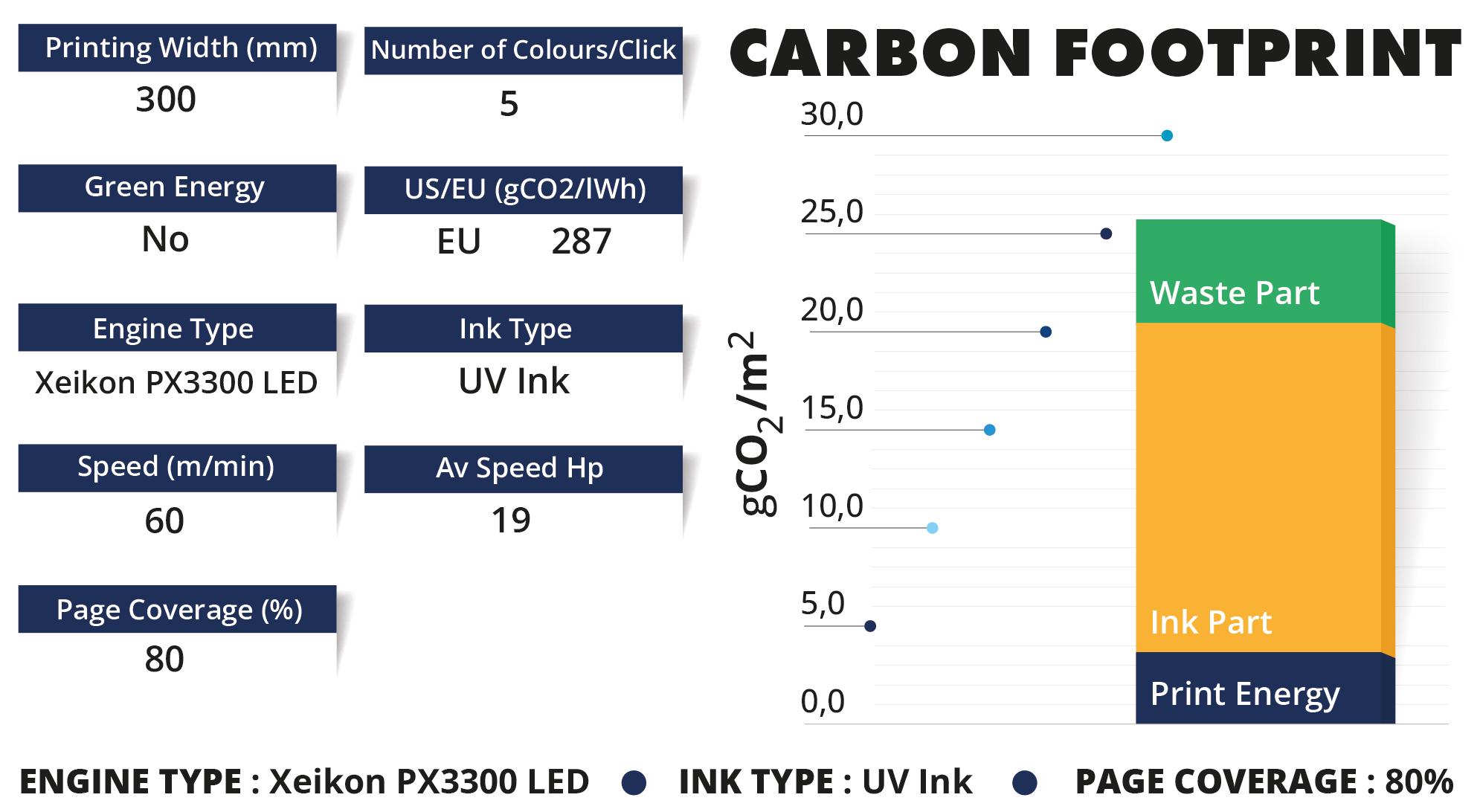

The main goal at Ultimate TechnoGraphics is to provide open, agnostic and intuitive solutions that are easy to integrate and that work well when combined as part of a broader solution or used as a standalone product. The Ultimate team values partnerships, collaboration and innovation through team effort.
The technologies Ultimate provide are modular and scalable and allow customers to start small and grow as their companies expand and their production requirements change. The unique software architecture is designed to work even in the most challenging print production environments.
Being very much in-tune with customers and their changing environment and challenges, Ultimate continues to create technology and develop innovation that meets not only the needs of print service providers today, but will continue to move forward and meet their challenges of the future.
As an award-winning advocate and evangelist of finishing automation since 2008, Ultimate continues to develop and expand its finishing automation technology and strengthen its partnerships and integrations beyond the 60 finishing devices that are currently supported today.
Ultimate is regarded as the standard in imposition and finishing automation, operating even in the most challenging print environments with ultra-short runs including book-of-one and very

high requirements regarding reliability, capability and speed. The future goal is to bring this competitive advantage into the various additional market segments in which customers are competing.
Some key innovations and functionality that have or are planned to be released in 2023:
Ultimate Impostrip Scalable’s BetterPDF module quickly re-engineers problem PDF files to the requirements of the output device, making them more efficient and faster to impose and output through the RIP or DFE.
A newly re-engineered True Shape Nesting innovation optimizes the layout of contour shapes on a sheet or roll automatically, which is ideal for folding carton and wide-format print work.
A fully dynamic and automated smart label layout generator is capable of doing easy step-and-repeat as well as maximizing jobs across lanes for high volumes of SKUS and VDP jobs.
A cloud version of Ultimate Impostrip is optimized for scalable containerized virtual environments.
On the way to Drupa 2024, Ultimate continues to find innovative ways to support customers in their daily challenges and strategic goals, be that through partnerships, tighter integrations or by the development of faster and more functional software.
Sponsored Content
Kyocera is a well-known producer of inkjet heads. What drove the company to launch its first production inkjet press, the TASKalfa Pro 15000c?
Jose Maria Estebanez
At Kyocera, our history inspires our future. While some considered us to be a rookie in the production print market, our inkjet printheads have been used by manufacturers in the industry for decades. The TASKalfa Pro 15000c represented the perfect opportunity for Kyocera to take its inkjet technology to the next level. We are meeting the needs of a clear niche in the production print market: an affordable entry point for PSPs that also offers a fantastic balance between productivity, quality and media flexibility.
WTT
Digital production color printing is a very competitive market. Which benefits of the TASKalfa Pro 15000c gained the most interest? How did those help overcome the recent challenges of printing companies?
JME
Installation is easy and no special power outlets are required. Businesses want to be able to use their technologies pretty much straight out of the box – that’s what they get with the TASKalfa Pro 15000c. Moreover, the robustness of this device and the few moving parts that it incorporates
means that maintenance visits are both rare and quick. The TASKalfa Pro 15000c allows our customers to get on with the job at hand, without the need for service calls. The extremely competitive price point of the device is proving to be attractive for PSPs seeking to take advantage of the benefits of sheet-fed inkjet and a growing market for more personalized, short-run printing. This has also been the case for organizations with higher-end devices – they are now able to add on-demand printing to their printing and drive new business in areas such as trans-promotional, direct mail and book publishing.
WTT
Service and support are crucial in production print. How did Kyocera make sure that customers are getting the best support?
JME
Service is everything here at Kyocera – it’s why we invest so much in terms of time and resources making sure that our dealers get the best possible sales and service training and support. We also hold a training competition each year whereby dealers are evaluated on their capabilities to offer service. Our inkjet printheads use a unique cleaning solution, which is released from a special nozzle at the end of the head to a cleaning blade while keeping the printhead dry. Any dried ink dissolves, and the surface is wiped clean. This means less manual maintenance and quicker service visits because
Sponsored Content
only ink cartridges, cleaning liquid and waste ink tanks need to be replaced – uptime has been calculated to be more than 96%.
Inkjet is still relatively new in the sheet-fed digital printing market. What do you tell prospects reluctant to move from toner to inkjet when looking into inkjet?

JME
Traditionally, laser was associated with high quality, but the technology itself was complex and challenging to maintain. What we are bringing to the table is a third option: technology that simplifies the complex. With inkjet we are offering a completely new set of benefits: brilliant quality on a lighter device. A device with our own Kyocera water-based inks making it even more environmentally friendly. Users of the TASKalfa Pro 15000c are finding the quality of the TASKalfa Pro 15000c comparable to laser printer output. With
an initial estimated duty cycle of one million pages per month, results from the field show that this number is up to three million!
How many printers have been installed since launch, and what types of companies invested in a TASKalfa Pro 15000c?
JME
We are very happy with how the product has performed to date. We now have over 200 units in the field here in the U.S. – we shouldn’t forget that the pandemic impacted sales for almost two years. Our portfolio of customers is diverse: commercial printers in marketing, direct mail, and transactional print, book publishing and in-plant operations.
Does the TASKalfa Pro 15000c help users to expand into new application areas as well?
JME
Absolutely. JHL Direct in the Midwest, for example, has been able to leverage the versatility and variable data applications of the TASKalfa Pro 15000c to drive business growth in the political fundraising industry. By simplifying complex variable data workflows, they have been able to enjoy overall savings of between 30%-50% on what they would normally run.
The TASKalfa Pro 15000c is quite fast given its size and investment. Are customers taking advantage of the productivity?
JME
This machine is for print volumes north of half a million images each month. On average, our customers are printing around 700,000 images per month, and it’s surpassing expectations in many respects.
Sponsored Content

SPESA, the Sewn Products Equipment and Suppliers of the Americas, is an industry association that represents suppliers to the industry, and plays a key role in the ability to streamline supply chains, bring textiles work back to the Americas, and find more ways to automate the sewing process, which has been the bottleneck to reshoring due to lack of sewing talent, among other things. The association is also focused on attracting new talent to the sewn products industry and finding innovative ways to train sewists, sewing machine mechanics and more.
When you say you represent the suppliers to the sewn products industry, what does that encompass?
Michael McDonald
That means anything that goes from taking a piece of fabric and turning it into a T-shirt, a car seat, a couch, an airplane wing, whatever it might be. We represent the suppliers of equipment and software and services that go into doing that. And so the bulk of our members manufacture cutting machines, sewing machines and printing machines. But we also get into the software realm with PLM (product lifecycle management) solutions, CAD, 3D design, as well as services, logistics, consulting and more. We exclusively represent
the suppliers to the industry. And we don’t have textile manufacturers, brands or retailers in our member base. We are a very niche association, but we represent a very dynamic and interesting segment of the industry.
WTT
When we think about sewn products, we usually think about needles. But it’s more than that, right?
MM
Of course. There is seam sealing and bonding, as well as all sorts of new 3D printing and knitting, new technologies that don’t necessarily involve traditional sewing. It often baffles people. Airplane wings are usually sewn on because it is one of the strongest bonds you can create. It’s not just apparel; it’s car seats, boat awnings and a lot more. It’s a very diverse group of manufacturing, and we are still struggling a bit to find the name that describes our entire industry.
WTT
So you have had a busy season with your Executive Conference in Puerto Rico, the TexProcess Americas show that took place in May, and now planning for a major event in Philadelphia in the fall. Let’s talk about the first two, and what the key outcomes of those events were.
MM
We are an in-person industry. There’s a lot you can do virtually, but there’s nothing like shaking a hand, seeing a face, and if you are looking at equipment, there are just some things that you can’t get across online. That’s why we are so glad to be getting back to in-person meetings and events. We chose Puerto Rico as the venue for our Executive Conference. People might not realize the breadth of the industry there. And, of course, it’s part of the United States, so fits in with the Made in America trend, especially for military uniforms and other government contract work.
An important part of the conference were the visits to three very different factories; a uniform manufacturer; a co-op up in the mountains making artisan handbags; and a very automated footwear manufacturer.
At TexProcess, we saw a lot of enthusiasm among attendees. I think people realize that now is the time to look at your processes and rethink a lot of the way we have always done things. Our exhibitors had a tremendous amount of innovation on display, giving visitors a lot to think about as they returned to their businesses. This included things like dyeing thread on demand, automated sewing and an increased amount of automated material handling that we hadn’t really seen before.
WTT
Normally this show is every other year; but because of the pandemic, you had shows in both 2022 and 2023.
MM Yes, and some exhibitors and attendees were a little concerned that we might not have enough new to show in 2023. But that concern was completely unfounded. There was a tremendous amount of innovation on display, and that gives us a good foundation to build on as we move toward the next TexProcess in 2025.
For those who attended either or both events, both exhibitors and attendees, what would you say are the two or three outcomes? What might they do differently as they go back home?

That’s a really good question. It’s hard to narrow it down. The greatest challenge in manufacturing in any industry is sewing automation. We’ve privatized space travel, but we haven’t figured out how to automate sewing a T-shirt. And the issue is really self-inflicted. Back in the 80s and 90s, instead of investing in automation, we invested in
cheaper labor. But inevitably, we will run out of cheaper labor. We were just kicking the can down the road instead of addressing the real issue. But now I think the industry realizes that the solution is automation, but that automation isn’t quite there yet. So the challenge we have is how to train a workforce and invest in automation to meet at the exact same place, so we have a trained workforce available when the automation gets there? The two really have to go hand in hand.


WTT
And really, if we are talking about reshoring or near-shoring, that has to happen, right?
At the show, we had a training pavilion to showcase how to train mechanics and engineers. In addition to sewists, that’s a dire need for today’s workforce. Another outcome is increased focus on building a regional supply chain. We have to work with Mexico, Central and South America and the Caribbean. They have the drive and the skill sets we need today, and they are excited about the opportunity to move those skills into the future.
WTT
In the United States, we do have some pockets where those skills exist. I was startled to learn that in L.A. there are 45,000 garment workers. There’s a pocket in Arizona, and in your state, North Carolina. St. Louis is starting to come back. But it is a big country, and pockets aren’t going to get the job done.
MM
One of the things we have been trying to do is map where the factories are. For example, we did a project in San Diego. At first glance, there were about 60 or 70 factories; but 40 of them were Etsy shops in a garage or something, with one sewing machine. And 10 of them hadn’t existed for years. It took us a month to sort all that out. So mapping the entire country is quite an overwhelming challenge. But we will keep at it. We have to know where we are to be able to better plan how to get to where we need to be. Plus, people need to understand that these factories are not what they used to be in the early 1900s, for example. They are typically clean, well-lit places to work. And of course, wages are an issue.
Attendees at Texprocess Americas 2023 speak with an exhibitor in the SEAMS Made in America pavilion.But the truth is, not much will change unless consumers drive that change. As long as they are buying that $5 T-shirt, wearing it once and throwing it away, the fashion industry will continue to fill that need. Sort of like the drug trade, you could say.

True. But although it can be a heartbreaking challenge, the opportunities are exciting. There is a tremendous amount of research being done into circularity, and how you use and reuse materials throughout a circular life cycle. There are many pilot projects happening, including how to separate out, for example, cotton from polyester in blended fabrics so the polyester can be recycled and reused. But the issue here is scalability; how fast these technologies can be proven, and then how fast they can scale.
It’s encouraging that SPESA is working hard on these issues, and we hope that progress continues. As we wrap up, anything else you want to add?
One of our big issues, especially in the government and military here in the U.S., is the fact that they have not really been putting their money and attention in the right places. One example is we do not have surge capacity if, God forbid, we needed to mobilize our military. We couldn’t even provide uniforms to everyone. And as you said, we need to do more to influence consumers, who will be the ones to drive change. All of that being said, I remain optimistic about the future of the industry. I think as we continue to build a workforce and develop more automation, we can reach that baseline where we get more cost and price efficiency.
One exciting thing coming up in October – we are hosting the International Apparel Federation’s World Fashion Convention. That conference has not been held in the U.S. for 25 years. And they are interested in seeing what the Western Hemisphere is capable of, from a manufacturing, innovation and fashion perspective. So we hope to see some encouraging outcomes from that conference as well.

Cheryl Kahanec is an industry-recognized expert in digital technology and solutions, as well as a frequent speaker featured and quoted in many leading industry publications. She has worked with major companies in the selection and development of products and services for the marketing communications industry, including HP, IBM, Canon, Landa, Kodak and Xerox.
Cheryl, you are well-known in the industry as a respected expert in digital printing. You were a very early pioneer in variable-data printing and have worked with some of the most forward-thinking companies in the industry and were recruited in 2018 into the role of CEO at Quantum Group. Can you talk a little about how you got from where you started to your role today?
Cheryl KahanecWe are all an accumulation of our experiences. I started out by getting a job as a typesetter, and I didn’t even know what that meant at the time. But that gave me an entry to an industry that I had no idea would take up the next 40-plus years of my life, and I would come to be a part of an industry that I absolutely love. I have worked for some great companies, and I have had wonderful mentors.
Diane Romano was an early mentor, and I still get advice from her to this day. So yes, I’ve had so many great experiences and opportunities, and I’ve had some that haven’t worked out so well. But good or bad, they all taught me something. And I think that’s what you must do - learn from every experience you have.
I wanted to be a leader in the industry. I wanted to be a person to help to move an industry forward, and this was my opportunity to do it. Some of the decisions that I made were very strategic because of that, and some of them were just opportunities that I became aware of and tried to take advantage of. I have so many friends because of this industry.
WTT
You were an influencer before that became a thing. And in those earlier days, you were often the only woman in the room, right?
CK
I love the fact that there are so many more women in the industry today. And yes, early on I was sometimes the only woman in the room. But I learned that it’s not bad to be the only person in a group that is different. Sometimes it is a real advantage. Because everyone else thinks,
“That person that’s different, I want to hear what they say. I want to hear what they think. Because they’re not one of us. They’re looking at it from a different perspective.” Well, I was one of them, but my opinion was sought out, and it allowed me to share my perspective with some of the others in the room. And it just gave me an opportunity to have a voice that I might not have had if I wasn’t the only woman in the room early on.
WTT
In your leadership career, you have always been at the forefront when it comes to implementing the latest and greatest equipment and technology, innovative products and services to your company’s clients. What’s your formula for staying ahead of the curve?

CK
My formula is to always understand that what is the best today has competition tomorrow. I try
very hard to keep good relationships with all the vendors, whether I have an interest in the technology they have today, or I don’t think that technology is the right fit for me. I still have an interest in it, because I want to have the best, and the best changes all the time.
Make the vendors your friends, make them support you, and you support them. If you have something that works well in your place, brag about it. If you have multiple things that work well, brag about all of them, because that’s good for the vendors. That helps them to sell and support their products and services, and it helps us to make those relationships stronger.
I talk with vendors that sell competitive products to those I’ve implemented all the time, and I always tell them the same thing; as you develop new products, keep me informed. I want to hear about it when it comes out. And they will educate me on its capabilities and where it fits in the market. Now I have another piece of information and knowledge to help me make better decisions going forward.
I think if you want to be a true leader you can’t discount anything, because we don’t know today what we might need tomorrow. We must evolve.
To paraphrase an ancient saying, “The only constant is change.” Change is certainly a defining characteristic of the printing industry. What is your approach to managing change?
CK
COVID taught us a lot. We all thought we were very dynamic and could just spin on a dime and come up with new ideas and creative ways to do things. And COVID said, “Nope. Everything’s going to be different.” You didn’t know what was happening with the supply chain. How would banking work? Will the post office still be open? You didn’t know if people were safe in your building, and that was a scary change.
I’ve said many times that we in the printing industry think we know what the customer wants or should want, and we have a sense of being in control. COVID taught us that we don’t control the world. The world controls us. We never shut down a day throughout the pandemic. I’m very proud that we didn’t have COVID spread in the building, because we changed our priorities.
We still had to serve our customers. One of the largest is a pharmaceutical company that had critical information they had to get out to their clients. The normal supply chain of getting printed material into the hands of sales reps, then to healthcare providers, then to patients, was broken. So we ended up doing a lot of direct-to-patient. Instead of sending a million boxes with all this information for providers, we were sending out letters and smaller packages directly to patients. We had to change what we were doing and how we were doing it, because the distribution channel changed, and this information had to get out.
WTT
Has the change in the labor market impacted your business?
CK
The labor market became terribly difficult during and after the pandemic. We had to become creative in how we found people. We got the opportunity to work with a local association that supports adults with cognitive issues and challenges. And with their support, we hired this wonderful group of about 15 people. They’re an incredibly loyal and hardworking team.
They’d been working with us for about two years, when I received a call from the association saying that Quantum had been voted Employer of the Year. I was pleased but flabbergasted, and when I asked why, they told us the reason was because we showed them respect. I think this award is the one I’m most proud of in my whole career.
WTT
And that was just one client! CK
Right. Another of my customers, a retailer of personal photography products, had a surge during the pandemic. Our numbers with them went sky-high - we were busier than ever, and we had to figure out how we were going to produce it all. So we worked as a team and we got through it. But the need drove the change. If I didn’t understand how to lead and change, prior, I most certainly understand it better today.
The biggest lesson was that you cannot always control change. You can’t decide this is what we’re going to become, and it just happens that way. That’s what we’re used to. Right? We’re used to coming up with the five-year plan or the seven-year plan. The need can come along to change all that, and it can happen any time.
You’ve often cited three simple questions that guide you and, by extension, the companies you lead. Can you tell us what those are and how they came to be your guiding principles?
CK
I worked for a company in New York City a long time ago, when I had a sign on my door that said, “Enter here only if you are here to tell me how we might and not why we can’t.” I explained to everybody that if you can’t tell me how we might, then don’t bother coming in, because I can already give you 10 reasons why we can’t.
“How we might” was my mother’s thing. She would say, “Don’t come to me whining, come to me with a possibility of fixing a situation, and I’ll help you do it. Tell me how we might and not why we can’t.” When I started to get into business and was in a position of making decisions, I would talk to one of my mentors with the notion “how we might.”
So that’s the initial formation of these basic questions, the first being, “Is it good for the customer?” The customer has to be first. Anybody can answer this. If what we’re doing is going to benefit our customers, well, they’re the ones that pay us, right? So, it has to be good for them.
Question two is, “Is it good for the company?” We must be profitable. It must be sustainable. Can I offer this benefit to other customers? If so, we can use it to expand and grow. So, it has to be good for the company as well.
And then, of course, ultimately, you know it’s that line in the sand. “Is it the right thing to do?” If you must do something wrong for something good to happen, it’s not the right thing to do. So those are the three simple questions - good for the customer, good for the company, right thing to do. If you answer yes to all three, do it - you can never be in trouble.
So those are your golden rules.
Those are my golden rules, and I ask everybody on the team to think about the rules when making decisions. Ask the questions and decide. I’ll back your decision. I may end up changing it ultimately because I have more information than you do. But the bottom line is, I’ll back you for making the decision based on the criteria. And I think if we did that every day, we would be so much better off. As people, we have a line of ethics, we always must do the right thing.
WTT
So speaking of your team, you’re managing a large organization with a very diverse client base providing often highly technical solutions at Quantum. As a CEO, how did you go about building your “dream team?”
CK
My personal philosophy is that everybody has a part to play in our success. And I think respect is very, very important. Whether your job is to sweep the floor, to work on a piece of equipment, to be in sales or production, or to be the CFO or CEO, we’re all equal in that we have a responsibility to be the best at what we can be. So, I think my whole company of employees is our dream team. I have an open-door policy, and anyone is welcome to come to me with ideas. I may not agree with them, but I do appreciate the fact that I see the effort it takes for them to walk in, sit down and have a conversation with me, and I need to respect and appreciate their part in making this organization successful. It’s easy to say “thank you.”
WTT
What would you say is the most important thing you do in your role as CEO?
CK
I am so grateful that I get to be in the room and learn about things, in some cases years before the industry does as a whole. But a leader must be able to sort it all out to say, this applies, and this is futuristic. Don’t discourage something that doesn’t work today, and think about it for the future, whether it’s personnel, financial or technology decisions. As a leader, you must think in multiple layers, and that’s hard to do. We need to have fewer closed-door conversations, because the more opinions you get the better your decisions are going to be.
My mentor said that there’s a responsibility that goes along with the privilege that we have in this industry. We are privileged to be able to be a leader. We’re privileged to be a part of such a great industry, and we should help others to have that same privilege. It boils down to responsibility. We need to be responsible to bring the next leaders in here and work with them. We need to be mentors ourselves.
Leadership is about doing things the right way.
That starts with a level of technical competence, and it brings out an important point—every member of your team can provide leadership by doing their job the right way.

Consider a low-level employee, maybe your bindery person, who does their job with precision and enthusiasm. Beyond the direct effect on efficiency and quality control, that person almost certainly makes a positive contribution to your company culture. Maybe another way to say that is, “That person is not a problem you have to solve.”
How about your own technical competence? Can you run a printing machine? Can you do prepress or design work? Can you manage a project through the shop? Can you sell? It is probably not important that you can do all of these things. That’s what your team is for, right? But even though you may not have to do the job, it’s important that you understand the job, at least well enough to correct any problems in the way it’s being done.
Why is that so important? Let’s go back to the idea of company culture. In a healthy culture, everyone does their job with precision and enthusiasm. In an unhealthy culture, only some of the people do. And those people—let’s call them your
“All Stars”—know who the others are, the ones who aren’t living up to the desired standards.
The right thing to do in this situation is pretty clear. You have to solve—or at least work on—the problem of these underperformers.
Here’s another definition of leadership, directly related to a small business like yours: “Leadership is providing a great place for great people to work.”
Brian Adam, my co-author on “Rules Of Engagement,” put it this way: “If I build the kind of company that the best people will want to work for, we’ll all be successful.”
So ask yourself: What kind of company would that be?
First and foremost, I think it would be a company about people, and about 75/25 oriented toward its own people.
Adam’s philosophy would apply: I take care of them, they take care of the customers, that takes care of all of us.
Second, it would be a company that was led rather than managed. To paraphrase the great management guru Peter Drucker, “In all things, do the right thing.”
It’s not unreasonable to think that people will follow.
Erwin Rommel was arguably the greatest general on any side in World War II. Rommel earned his nickname “The Desert Fox” for his brilliant machinations in North Africa in 1941–42. His offensive tactics were highly successful, but by October of 1942 he had stretched his supply lines so far to the east that he was forced to adopt a more defensive position.
In addition, Rommel himself wasn’t in the best of health. And, he was literally out of gas. He was in trouble, and he knew it.
Someone else knew that the Desert Fox and his Afrika Korps were out of fuel. Bernard Montgomery had taken command of the Eighth Army in August and almost immediately had his first skirmish with Rommel.

Criticized for not pressing Rommel further at the time, Montgomery replied calmly that hasty action might very well spoil the plans he was carefully laying for decisive battle, plans which he stated would take some two months to implement.
Montgomery canceled all plans for retreat, declaring, “The defense of Egypt lies here at Alamein….Here we will stand and fight; there will be no further withdrawal. I have ordered that all plans and instructions dealing with further withdrawal are to be burnt, and at once. We will stand and fight here.”
Entire books have been written about the Battle of El Alamein. It is still discussed by military strategists and historians. Suffice it to say that
after two months of meticulous preparation (and morale-building among the previously disheartened troops) the battle took place as Montgomery planned, in the amount of time he had forecast with the number of casualties he predicted.
The Battle of El Alamein marked a (some say the) decisive turning point in World War II. After El Alamein the Axis forces in North Africa were doomed, and entirely gone in six months.
As leaders, we don’t always have the option of taking as much time as we need to carefully plan and implement our strategies… or do we? If we carefully consider, in business (unlike war) we often really do have the luxury of taking the time we need to research, plot and launch our next moves. Our era sometimes glorifies recklessness and rash decisions, but going down in a blaze of glory doesn’t really help anyone. “Pause, plan and proceed” is often better advice than “lead, follow or get out of the way.”
We use the metaphor of lemmings racing to the sea to criticize those who blindly follow, but think: one lemming is out in front. He looks over his shoulder and is exhilarated to see thousands of followers. He is a leader, no doubt, and in his haste he is leading himself and his followers to their imminent destruction.
You took a minute to read this story. You’ve paused. Now take some more time to plan before you proceed.

















